Organisation of the Body: Human Biology Assignment - SAQs & Essay
VerifiedAdded on 2023/01/06
|22
|3965
|51
Homework Assignment
AI Summary
This assignment delves into the intricacies of human body organisation, covering topics from the smallest molecules to whole organisms. It begins by arranging the levels of organisation in order of size and then explores the functions of various organ systems, including respiratory, circulatory, a...
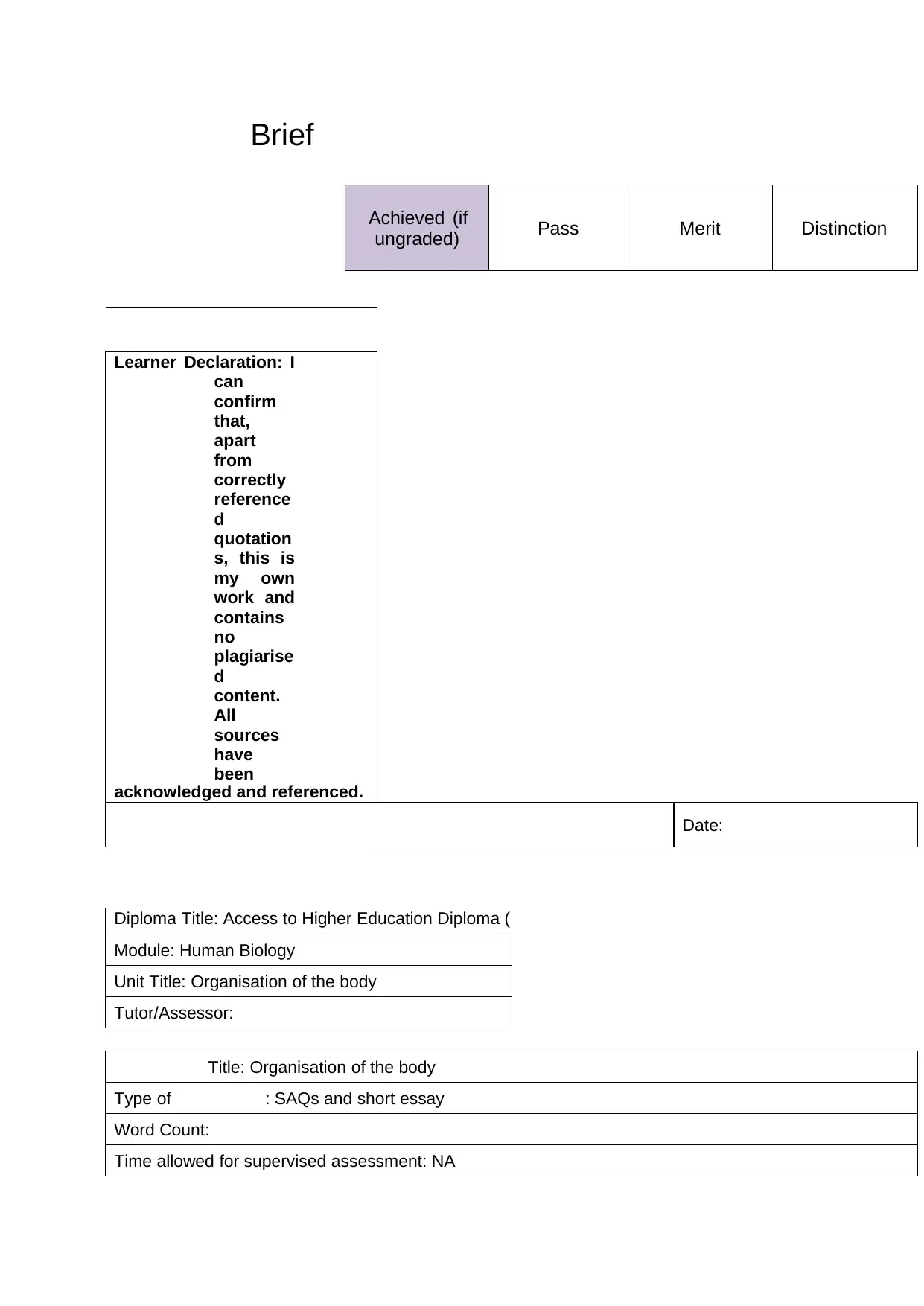
Brief
Achieved (if
ungraded) Pass Merit Distinction
Learner Declaration: I
can
confirm
that,
apart
from
correctly
reference
d
quotation
s, this is
my own
work and
contains
no
plagiarise
d
content.
All
sources
have
been
acknowledged and referenced.
Date:
Diploma Title: Access to Higher Education Diploma (
Module: Human Biology
Unit Title: Organisation of the body
Tutor/Assessor:
Title: Organisation of the body
Type of : SAQs and short essay
Word Count:
Time allowed for supervised assessment: NA
Achieved (if
ungraded) Pass Merit Distinction
Learner Declaration: I
can
confirm
that,
apart
from
correctly
reference
d
quotation
s, this is
my own
work and
contains
no
plagiarise
d
content.
All
sources
have
been
acknowledged and referenced.
Date:
Diploma Title: Access to Higher Education Diploma (
Module: Human Biology
Unit Title: Organisation of the body
Tutor/Assessor:
Title: Organisation of the body
Type of : SAQs and short essay
Word Count:
Time allowed for supervised assessment: NA
Secure Best Marks with AI Grader
Need help grading? Try our AI Grader for instant feedback on your assignments.
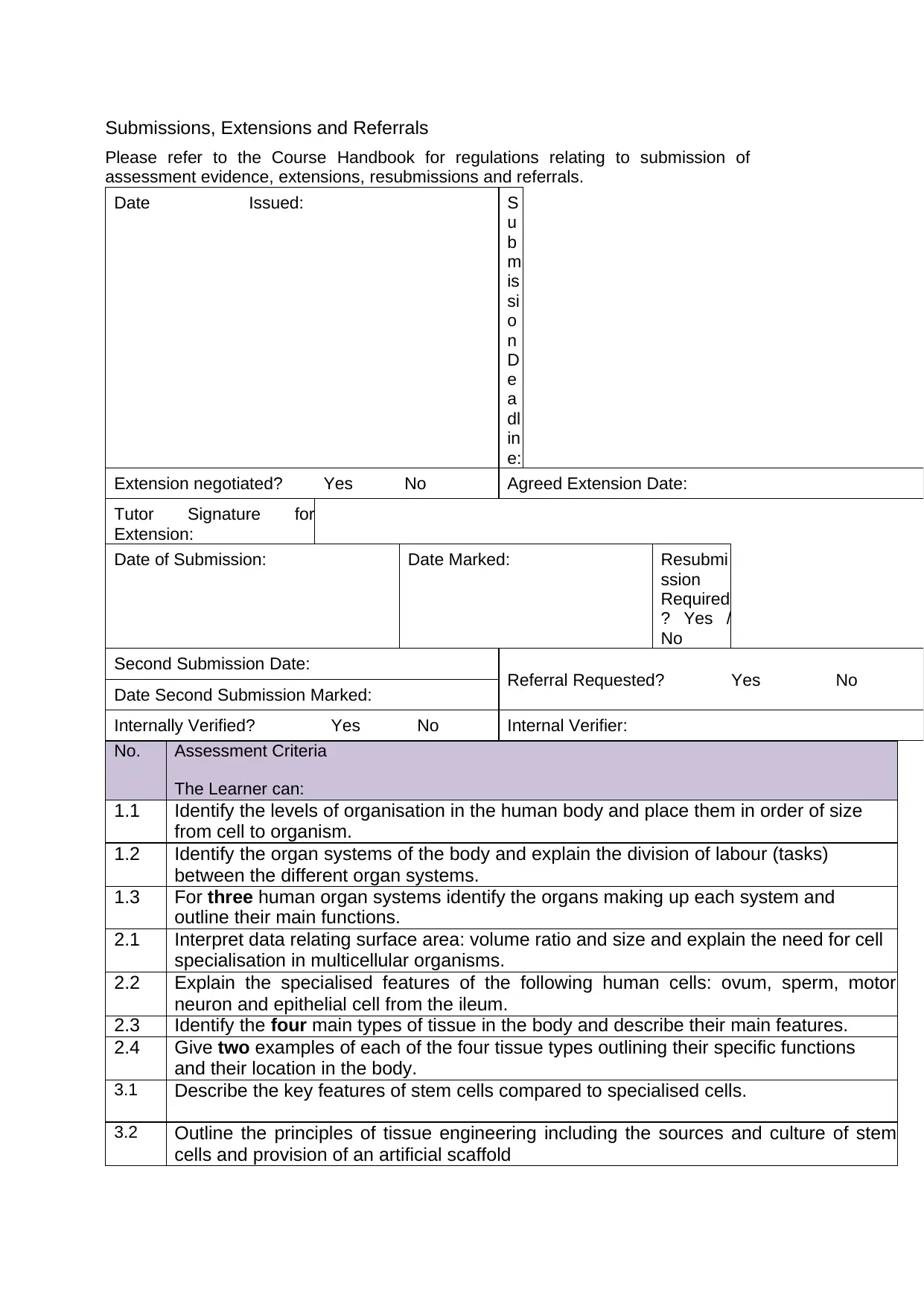
Submissions, Extensions and Referrals
Please refer to the Course Handbook for regulations relating to submission of
assessment evidence, extensions, resubmissions and referrals.
Date Issued: S
u
b
m
is
si
o
n
D
e
a
dl
in
e:
Extension negotiated? Yes No Agreed Extension Date:
Tutor Signature for
Extension:
Date of Submission: Date Marked: Resubmi
ssion
Required
? Yes /
No
Second Submission Date: Referral Requested? Yes No
Date Second Submission Marked:
Internally Verified? Yes No Internal Verifier:
No. Assessment Criteria
The Learner can:
1.1 Identify the levels of organisation in the human body and place them in order of size
from cell to organism.
1.2 Identify the organ systems of the body and explain the division of labour (tasks)
between the different organ systems.
1.3 For three human organ systems identify the organs making up each system and
outline their main functions.
2.1 Interpret data relating surface area: volume ratio and size and explain the need for cell
specialisation in multicellular organisms.
2.2 Explain the specialised features of the following human cells: ovum, sperm, motor
neuron and epithelial cell from the ileum.
2.3 Identify the four main types of tissue in the body and describe their main features.
2.4 Give two examples of each of the four tissue types outlining their specific functions
and their location in the body.
3.1 Describe the key features of stem cells compared to specialised cells.
3.2 Outline the principles of tissue engineering including the sources and culture of stem
cells and provision of an artificial scaffold
Please refer to the Course Handbook for regulations relating to submission of
assessment evidence, extensions, resubmissions and referrals.
Date Issued: S
u
b
m
is
si
o
n
D
e
a
dl
in
e:
Extension negotiated? Yes No Agreed Extension Date:
Tutor Signature for
Extension:
Date of Submission: Date Marked: Resubmi
ssion
Required
? Yes /
No
Second Submission Date: Referral Requested? Yes No
Date Second Submission Marked:
Internally Verified? Yes No Internal Verifier:
No. Assessment Criteria
The Learner can:
1.1 Identify the levels of organisation in the human body and place them in order of size
from cell to organism.
1.2 Identify the organ systems of the body and explain the division of labour (tasks)
between the different organ systems.
1.3 For three human organ systems identify the organs making up each system and
outline their main functions.
2.1 Interpret data relating surface area: volume ratio and size and explain the need for cell
specialisation in multicellular organisms.
2.2 Explain the specialised features of the following human cells: ovum, sperm, motor
neuron and epithelial cell from the ileum.
2.3 Identify the four main types of tissue in the body and describe their main features.
2.4 Give two examples of each of the four tissue types outlining their specific functions
and their location in the body.
3.1 Describe the key features of stem cells compared to specialised cells.
3.2 Outline the principles of tissue engineering including the sources and culture of stem
cells and provision of an artificial scaffold
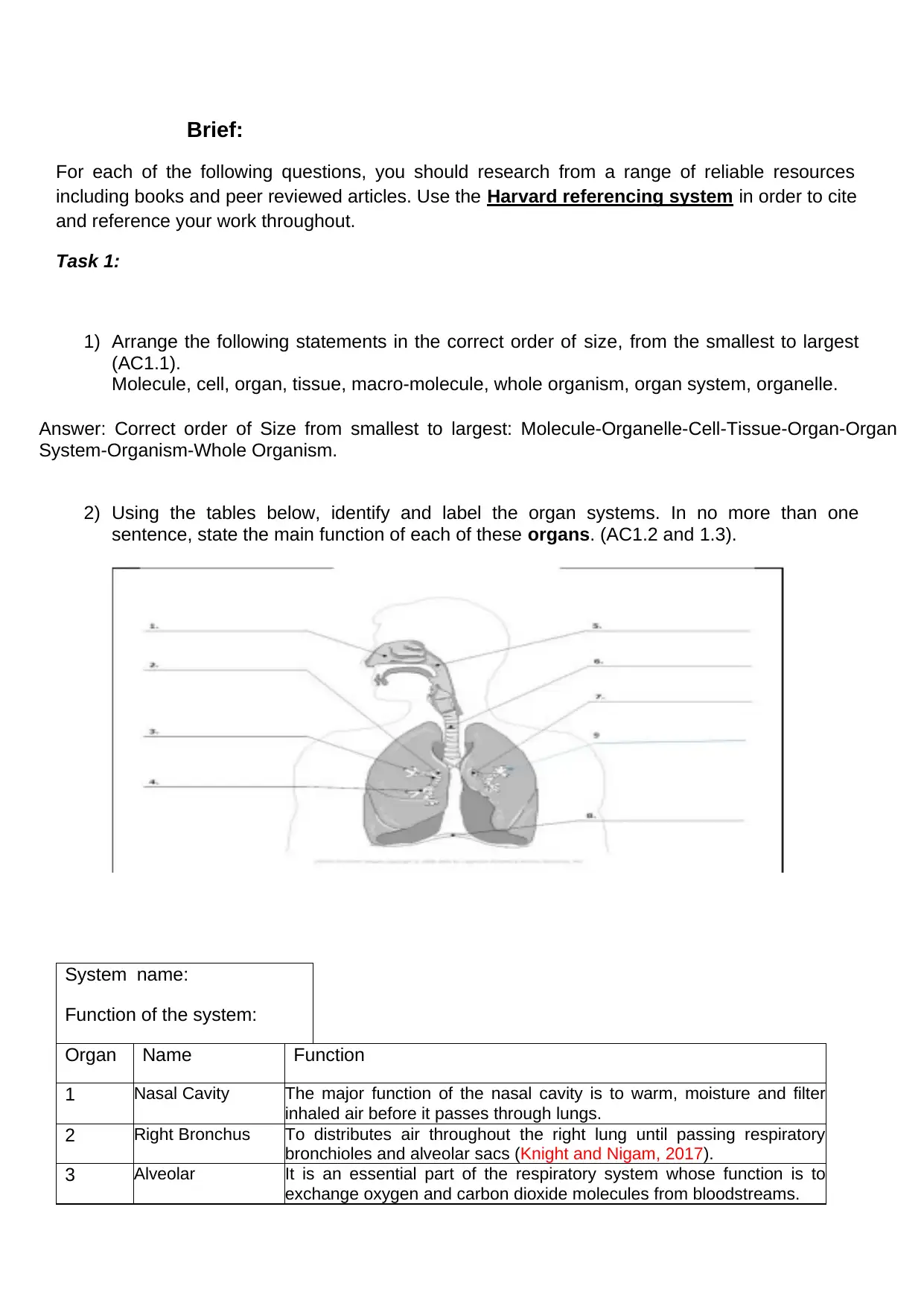
Brief:
For each of the following questions, you should research from a range of reliable resources
including books and peer reviewed articles. Use the Harvard referencing system in order to cite
and reference your work throughout.
Task 1:
1) Arrange the following statements in the correct order of size, from the smallest to largest
(AC1.1).
Molecule, cell, organ, tissue, macro-molecule, whole organism, organ system, organelle.
Answer: Correct order of Size from smallest to largest: Molecule-Organelle-Cell-Tissue-Organ-Organ
System-Organism-Whole Organism.
2) Using the tables below, identify and label the organ systems. In no more than one
sentence, state the main function of each of these organs. (AC1.2 and 1.3).
System name:
Function of the system:
Organ Name Function
1 Nasal Cavity The major function of the nasal cavity is to warm, moisture and filter
inhaled air before it passes through lungs.
2 Right Bronchus To distributes air throughout the right lung until passing respiratory
bronchioles and alveolar sacs (Knight and Nigam, 2017).
3 Alveolar It is an essential part of the respiratory system whose function is to
exchange oxygen and carbon dioxide molecules from bloodstreams.
For each of the following questions, you should research from a range of reliable resources
including books and peer reviewed articles. Use the Harvard referencing system in order to cite
and reference your work throughout.
Task 1:
1) Arrange the following statements in the correct order of size, from the smallest to largest
(AC1.1).
Molecule, cell, organ, tissue, macro-molecule, whole organism, organ system, organelle.
Answer: Correct order of Size from smallest to largest: Molecule-Organelle-Cell-Tissue-Organ-Organ
System-Organism-Whole Organism.
2) Using the tables below, identify and label the organ systems. In no more than one
sentence, state the main function of each of these organs. (AC1.2 and 1.3).
System name:
Function of the system:
Organ Name Function
1 Nasal Cavity The major function of the nasal cavity is to warm, moisture and filter
inhaled air before it passes through lungs.
2 Right Bronchus To distributes air throughout the right lung until passing respiratory
bronchioles and alveolar sacs (Knight and Nigam, 2017).
3 Alveolar It is an essential part of the respiratory system whose function is to
exchange oxygen and carbon dioxide molecules from bloodstreams.
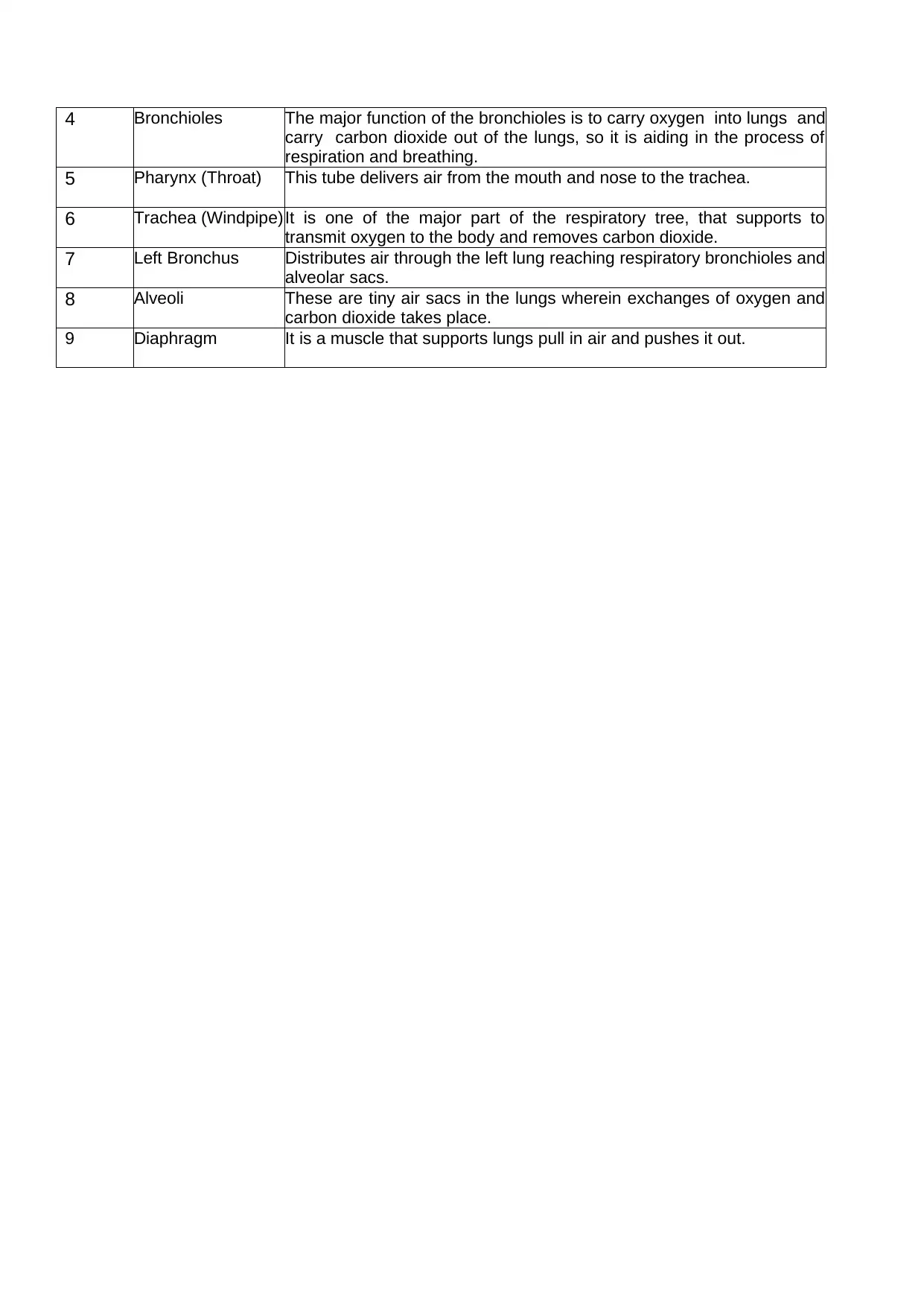
4 Bronchioles The major function of the bronchioles is to carry oxygen into lungs and
carry carbon dioxide out of the lungs, so it is aiding in the process of
respiration and breathing.
5 Pharynx (Throat) This tube delivers air from the mouth and nose to the trachea.
6 Trachea (Windpipe)It is one of the major part of the respiratory tree, that supports to
transmit oxygen to the body and removes carbon dioxide.
7 Left Bronchus Distributes air through the left lung reaching respiratory bronchioles and
alveolar sacs.
8 Alveoli These are tiny air sacs in the lungs wherein exchanges of oxygen and
carbon dioxide takes place.
9 Diaphragm It is a muscle that supports lungs pull in air and pushes it out.
carry carbon dioxide out of the lungs, so it is aiding in the process of
respiration and breathing.
5 Pharynx (Throat) This tube delivers air from the mouth and nose to the trachea.
6 Trachea (Windpipe)It is one of the major part of the respiratory tree, that supports to
transmit oxygen to the body and removes carbon dioxide.
7 Left Bronchus Distributes air through the left lung reaching respiratory bronchioles and
alveolar sacs.
8 Alveoli These are tiny air sacs in the lungs wherein exchanges of oxygen and
carbon dioxide takes place.
9 Diaphragm It is a muscle that supports lungs pull in air and pushes it out.
Secure Best Marks with AI Grader
Need help grading? Try our AI Grader for instant feedback on your assignments.
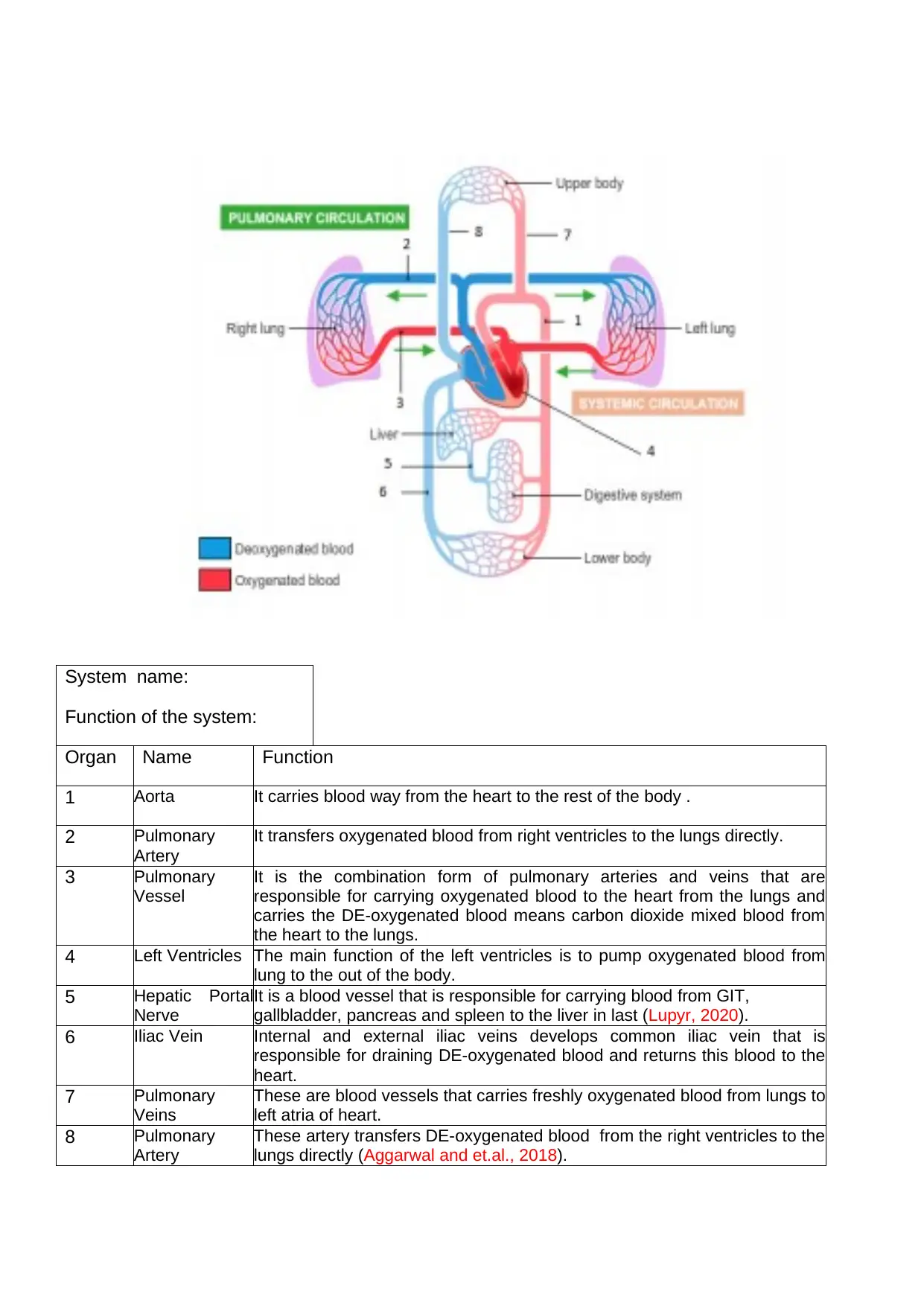
System name:
Function of the system:
Organ Name Function
1 Aorta It carries blood way from the heart to the rest of the body .
2 Pulmonary
Artery
It transfers oxygenated blood from right ventricles to the lungs directly.
3 Pulmonary
Vessel
It is the combination form of pulmonary arteries and veins that are
responsible for carrying oxygenated blood to the heart from the lungs and
carries the DE-oxygenated blood means carbon dioxide mixed blood from
the heart to the lungs.
4 Left Ventricles The main function of the left ventricles is to pump oxygenated blood from
lung to the out of the body.
5 Hepatic Portal
Nerve
It is a blood vessel that is responsible for carrying blood from GIT,
gallbladder, pancreas and spleen to the liver in last (Lupyr, 2020).
6 Iliac Vein Internal and external iliac veins develops common iliac vein that is
responsible for draining DE-oxygenated blood and returns this blood to the
heart.
7 Pulmonary
Veins
These are blood vessels that carries freshly oxygenated blood from lungs to
left atria of heart.
8 Pulmonary
Artery
These artery transfers DE-oxygenated blood from the right ventricles to the
lungs directly (Aggarwal and et.al., 2018).
Function of the system:
Organ Name Function
1 Aorta It carries blood way from the heart to the rest of the body .
2 Pulmonary
Artery
It transfers oxygenated blood from right ventricles to the lungs directly.
3 Pulmonary
Vessel
It is the combination form of pulmonary arteries and veins that are
responsible for carrying oxygenated blood to the heart from the lungs and
carries the DE-oxygenated blood means carbon dioxide mixed blood from
the heart to the lungs.
4 Left Ventricles The main function of the left ventricles is to pump oxygenated blood from
lung to the out of the body.
5 Hepatic Portal
Nerve
It is a blood vessel that is responsible for carrying blood from GIT,
gallbladder, pancreas and spleen to the liver in last (Lupyr, 2020).
6 Iliac Vein Internal and external iliac veins develops common iliac vein that is
responsible for draining DE-oxygenated blood and returns this blood to the
heart.
7 Pulmonary
Veins
These are blood vessels that carries freshly oxygenated blood from lungs to
left atria of heart.
8 Pulmonary
Artery
These artery transfers DE-oxygenated blood from the right ventricles to the
lungs directly (Aggarwal and et.al., 2018).
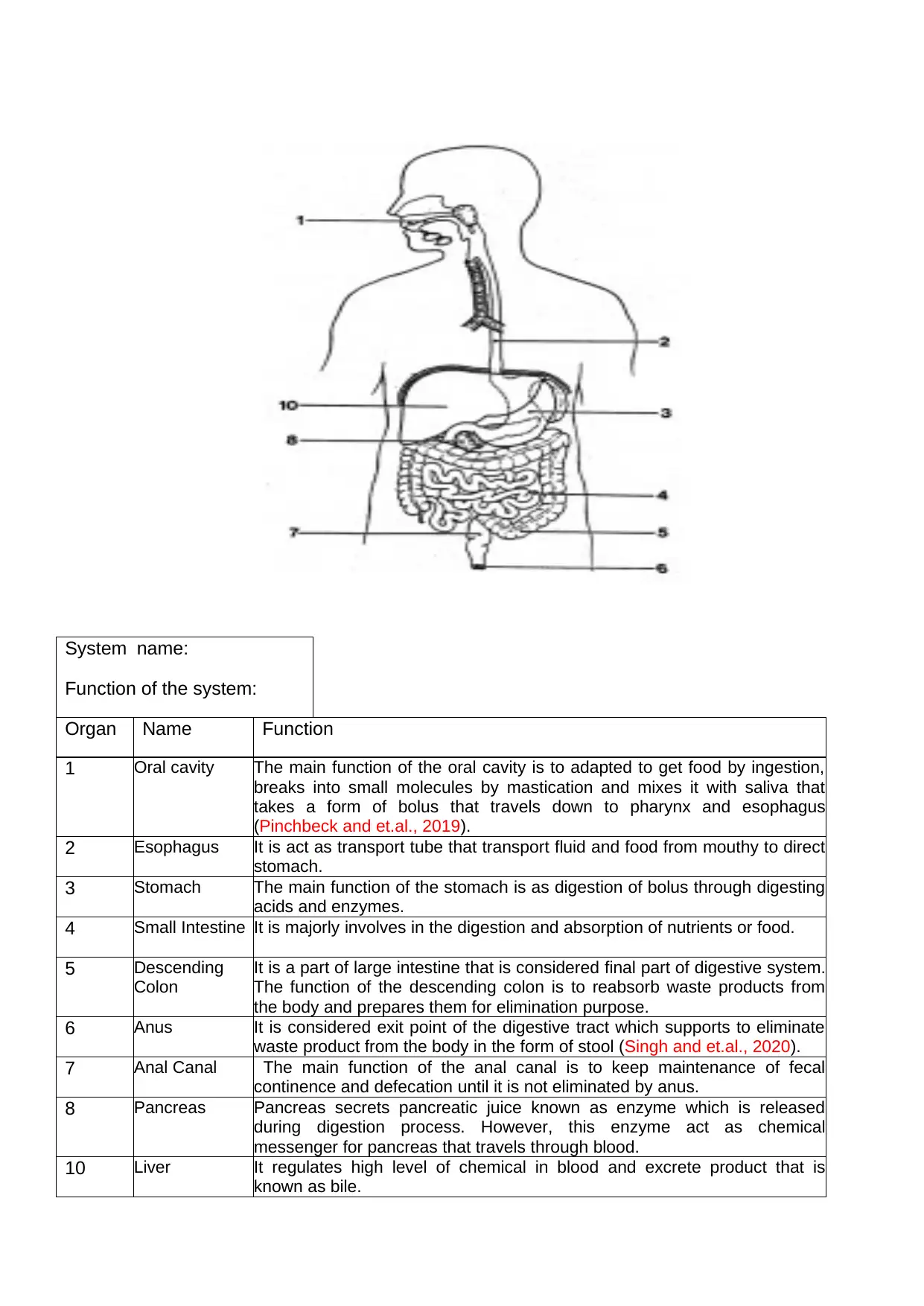
System name:
Function of the system:
Organ Name Function
1 Oral cavity The main function of the oral cavity is to adapted to get food by ingestion,
breaks into small molecules by mastication and mixes it with saliva that
takes a form of bolus that travels down to pharynx and esophagus
(Pinchbeck and et.al., 2019).
2 Esophagus It is act as transport tube that transport fluid and food from mouthy to direct
stomach.
3 Stomach The main function of the stomach is as digestion of bolus through digesting
acids and enzymes.
4 Small Intestine It is majorly involves in the digestion and absorption of nutrients or food.
5 Descending
Colon
It is a part of large intestine that is considered final part of digestive system.
The function of the descending colon is to reabsorb waste products from
the body and prepares them for elimination purpose.
6 Anus It is considered exit point of the digestive tract which supports to eliminate
waste product from the body in the form of stool (Singh and et.al., 2020).
7 Anal Canal The main function of the anal canal is to keep maintenance of fecal
continence and defecation until it is not eliminated by anus.
8 Pancreas Pancreas secrets pancreatic juice known as enzyme which is released
during digestion process. However, this enzyme act as chemical
messenger for pancreas that travels through blood.
10 Liver It regulates high level of chemical in blood and excrete product that is
known as bile.
Function of the system:
Organ Name Function
1 Oral cavity The main function of the oral cavity is to adapted to get food by ingestion,
breaks into small molecules by mastication and mixes it with saliva that
takes a form of bolus that travels down to pharynx and esophagus
(Pinchbeck and et.al., 2019).
2 Esophagus It is act as transport tube that transport fluid and food from mouthy to direct
stomach.
3 Stomach The main function of the stomach is as digestion of bolus through digesting
acids and enzymes.
4 Small Intestine It is majorly involves in the digestion and absorption of nutrients or food.
5 Descending
Colon
It is a part of large intestine that is considered final part of digestive system.
The function of the descending colon is to reabsorb waste products from
the body and prepares them for elimination purpose.
6 Anus It is considered exit point of the digestive tract which supports to eliminate
waste product from the body in the form of stool (Singh and et.al., 2020).
7 Anal Canal The main function of the anal canal is to keep maintenance of fecal
continence and defecation until it is not eliminated by anus.
8 Pancreas Pancreas secrets pancreatic juice known as enzyme which is released
during digestion process. However, this enzyme act as chemical
messenger for pancreas that travels through blood.
10 Liver It regulates high level of chemical in blood and excrete product that is
known as bile.
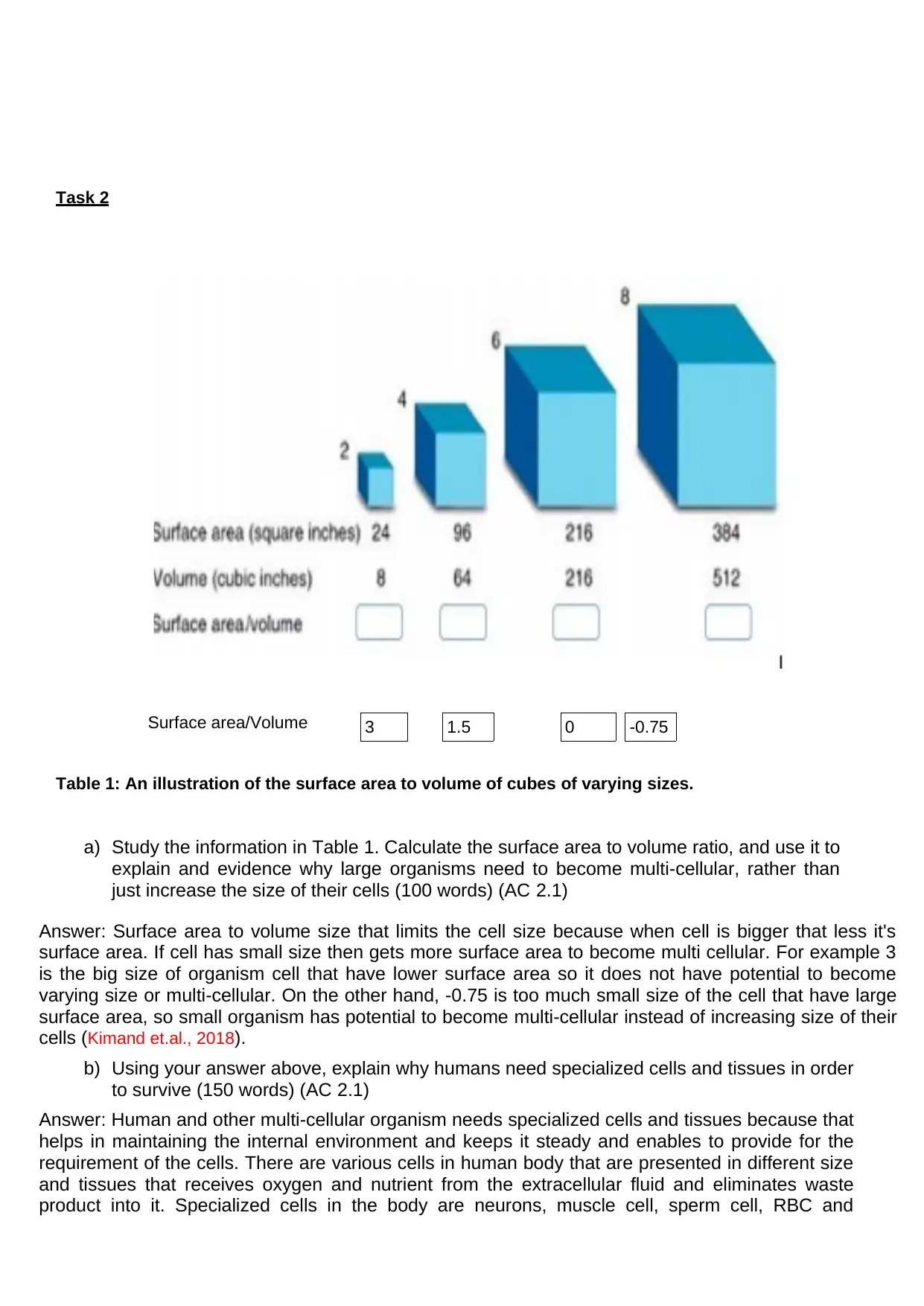
Task 2
Surface area/Volume 3 1.5 0 -0.75
Table 1: An illustration of the surface area to volume of cubes of varying sizes.
a) Study the information in Table 1. Calculate the surface area to volume ratio, and use it to
explain and evidence why large organisms need to become multi-cellular, rather than
just increase the size of their cells (100 words) (AC 2.1)
Answer: Surface area to volume size that limits the cell size because when cell is bigger that less it's
surface area. If cell has small size then gets more surface area to become multi cellular. For example 3
is the big size of organism cell that have lower surface area so it does not have potential to become
varying size or multi-cellular. On the other hand, -0.75 is too much small size of the cell that have large
surface area, so small organism has potential to become multi-cellular instead of increasing size of their
cells (Kimand et.al., 2018).
b) Using your answer above, explain why humans need specialized cells and tissues in order
to survive (150 words) (AC 2.1)
Answer: Human and other multi-cellular organism needs specialized cells and tissues because that
helps in maintaining the internal environment and keeps it steady and enables to provide for the
requirement of the cells. There are various cells in human body that are presented in different size
and tissues that receives oxygen and nutrient from the extracellular fluid and eliminates waste
product into it. Specialized cells in the body are neurons, muscle cell, sperm cell, RBC and
Surface area/Volume 3 1.5 0 -0.75
Table 1: An illustration of the surface area to volume of cubes of varying sizes.
a) Study the information in Table 1. Calculate the surface area to volume ratio, and use it to
explain and evidence why large organisms need to become multi-cellular, rather than
just increase the size of their cells (100 words) (AC 2.1)
Answer: Surface area to volume size that limits the cell size because when cell is bigger that less it's
surface area. If cell has small size then gets more surface area to become multi cellular. For example 3
is the big size of organism cell that have lower surface area so it does not have potential to become
varying size or multi-cellular. On the other hand, -0.75 is too much small size of the cell that have large
surface area, so small organism has potential to become multi-cellular instead of increasing size of their
cells (Kimand et.al., 2018).
b) Using your answer above, explain why humans need specialized cells and tissues in order
to survive (150 words) (AC 2.1)
Answer: Human and other multi-cellular organism needs specialized cells and tissues because that
helps in maintaining the internal environment and keeps it steady and enables to provide for the
requirement of the cells. There are various cells in human body that are presented in different size
and tissues that receives oxygen and nutrient from the extracellular fluid and eliminates waste
product into it. Specialized cells in the body are neurons, muscle cell, sperm cell, RBC and
Paraphrase This Document
Need a fresh take? Get an instant paraphrase of this document with our AI Paraphraser

leukocyte. These cells form different tissue in body which are responsible for performing different
activities in body. Neuron are smaller in width but length is large so it is spread all over the body
that transfers message to different organs and instructs them for functioning purpose. Thus,
specialized tissue and cells supports to survive in the external environment.
activities in body. Neuron are smaller in width but length is large so it is spread all over the body
that transfers message to different organs and instructs them for functioning purpose. Thus,
specialized tissue and cells supports to survive in the external environment.
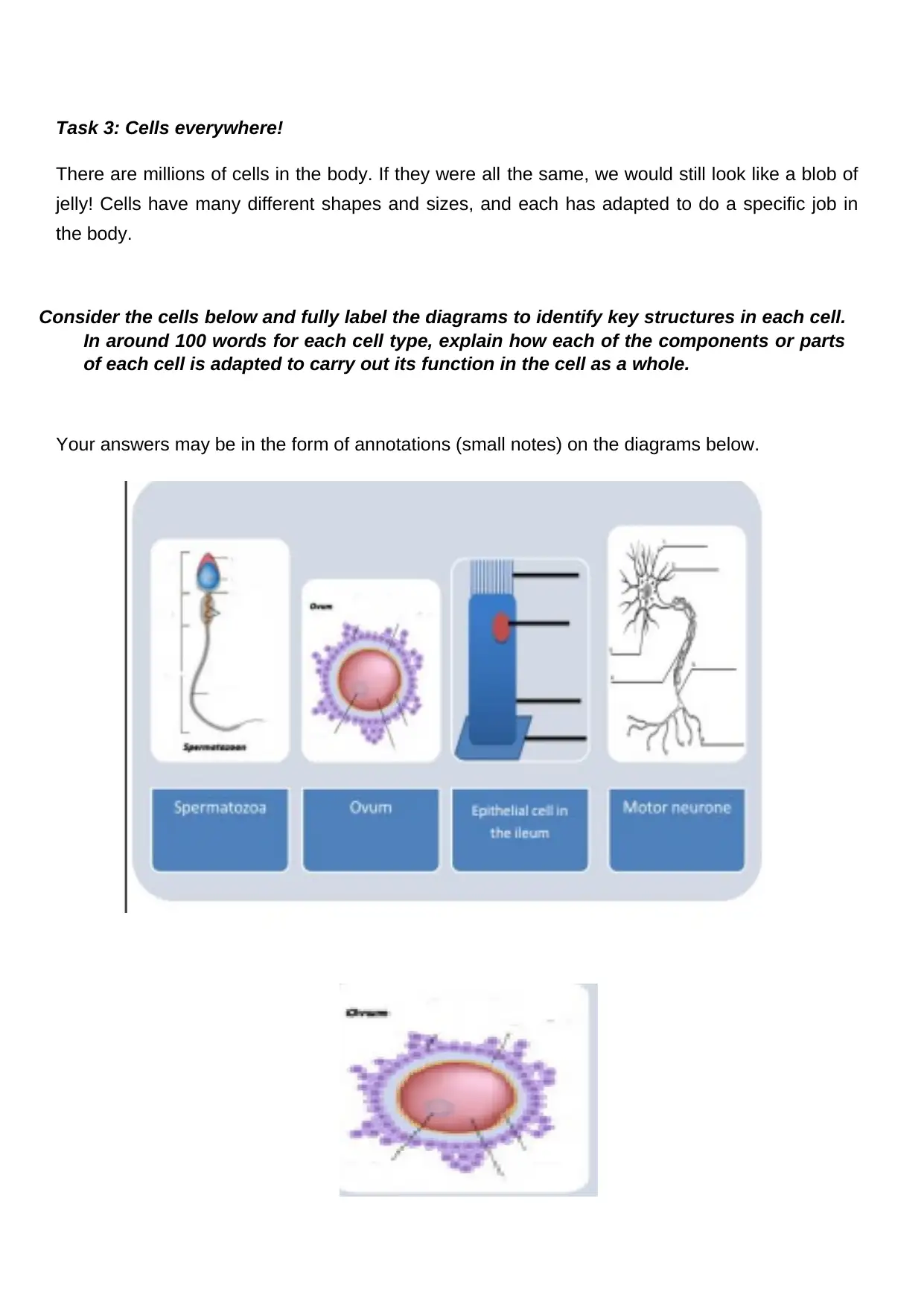
Task 3: Cells everywhere!
There are millions of cells in the body. If they were all the same, we would still look like a blob of
jelly! Cells have many different shapes and sizes, and each has adapted to do a specific job in
the body.
Consider the cells below and fully label the diagrams to identify key structures in each cell.
In around 100 words for each cell type, explain how each of the components or parts
of each cell is adapted to carry out its function in the cell as a whole.
Your answers may be in the form of annotations (small notes) on the diagrams below.
There are millions of cells in the body. If they were all the same, we would still look like a blob of
jelly! Cells have many different shapes and sizes, and each has adapted to do a specific job in
the body.
Consider the cells below and fully label the diagrams to identify key structures in each cell.
In around 100 words for each cell type, explain how each of the components or parts
of each cell is adapted to carry out its function in the cell as a whole.
Your answers may be in the form of annotations (small notes) on the diagrams below.

Secure Best Marks with AI Grader
Need help grading? Try our AI Grader for instant feedback on your assignments.
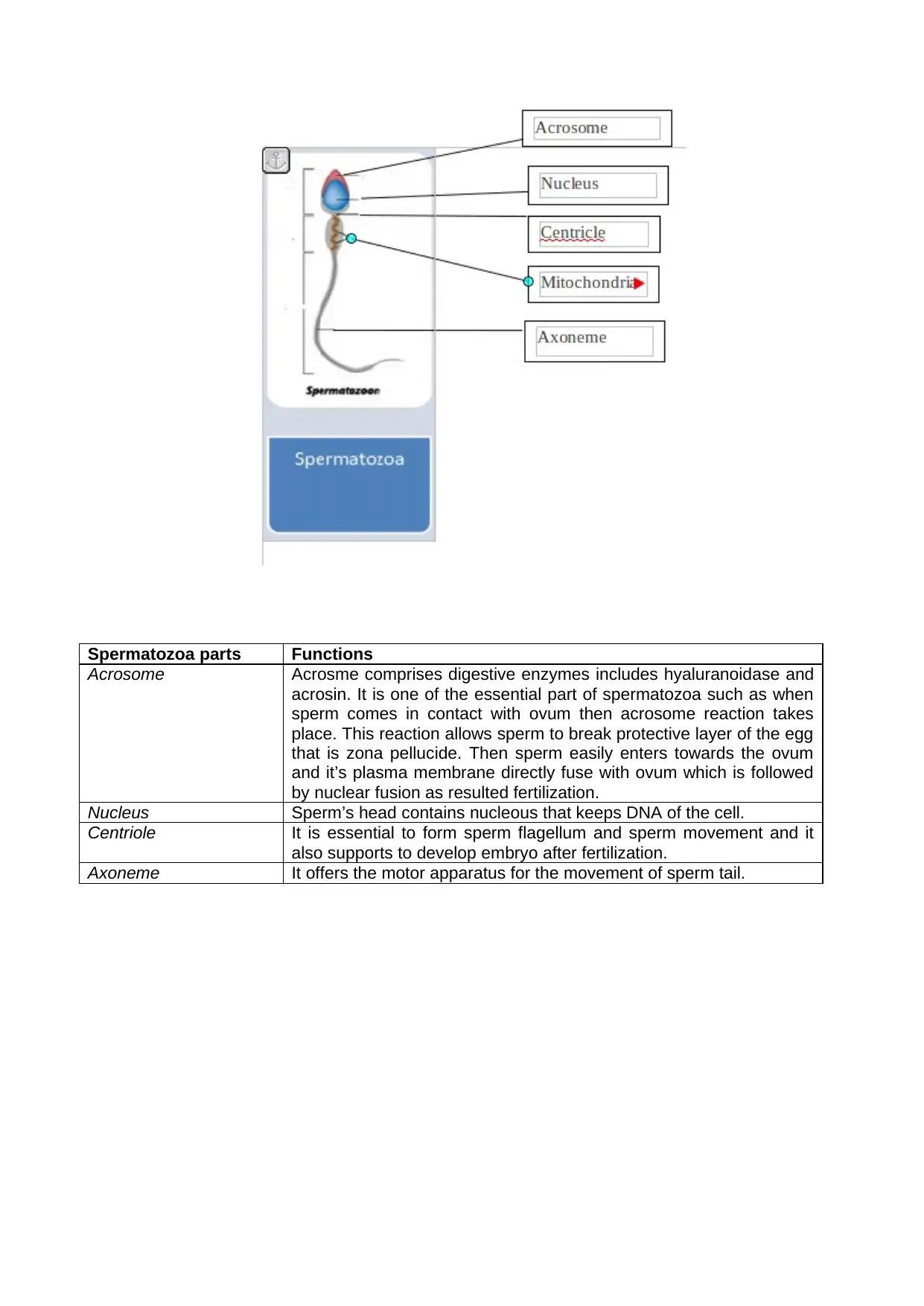
Spermatozoa parts Functions
Acrosome Acrosme comprises digestive enzymes includes hyaluranoidase and
acrosin. It is one of the essential part of spermatozoa such as when
sperm comes in contact with ovum then acrosome reaction takes
place. This reaction allows sperm to break protective layer of the egg
that is zona pellucide. Then sperm easily enters towards the ovum
and it’s plasma membrane directly fuse with ovum which is followed
by nuclear fusion as resulted fertilization.
Nucleus Sperm’s head contains nucleous that keeps DNA of the cell.
Centriole It is essential to form sperm flagellum and sperm movement and it
also supports to develop embryo after fertilization.
Axoneme It offers the motor apparatus for the movement of sperm tail.
Acrosome Acrosme comprises digestive enzymes includes hyaluranoidase and
acrosin. It is one of the essential part of spermatozoa such as when
sperm comes in contact with ovum then acrosome reaction takes
place. This reaction allows sperm to break protective layer of the egg
that is zona pellucide. Then sperm easily enters towards the ovum
and it’s plasma membrane directly fuse with ovum which is followed
by nuclear fusion as resulted fertilization.
Nucleus Sperm’s head contains nucleous that keeps DNA of the cell.
Centriole It is essential to form sperm flagellum and sperm movement and it
also supports to develop embryo after fertilization.
Axoneme It offers the motor apparatus for the movement of sperm tail.
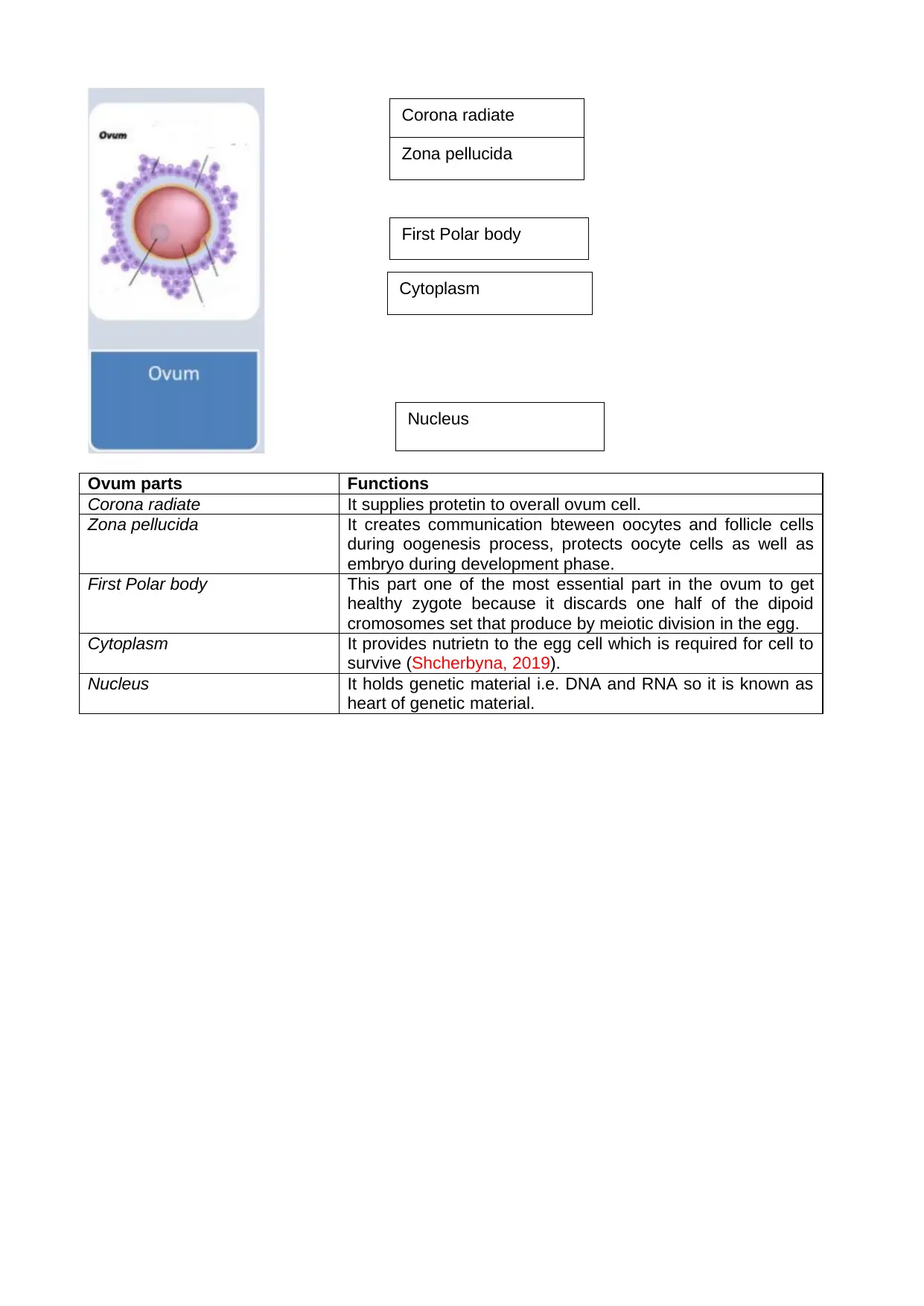
Ovum parts Functions
Corona radiate It supplies protetin to overall ovum cell.
Zona pellucida It creates communication bteween oocytes and follicle cells
during oogenesis process, protects oocyte cells as well as
embryo during development phase.
First Polar body This part one of the most essential part in the ovum to get
healthy zygote because it discards one half of the dipoid
cromosomes set that produce by meiotic division in the egg.
Cytoplasm It provides nutrietn to the egg cell which is required for cell to
survive (Shcherbyna, 2019).
Nucleus It holds genetic material i.e. DNA and RNA so it is known as
heart of genetic material.
Corona radiate
Zona pellucida
First Polar body
Cytoplasm
Nucleus
Corona radiate It supplies protetin to overall ovum cell.
Zona pellucida It creates communication bteween oocytes and follicle cells
during oogenesis process, protects oocyte cells as well as
embryo during development phase.
First Polar body This part one of the most essential part in the ovum to get
healthy zygote because it discards one half of the dipoid
cromosomes set that produce by meiotic division in the egg.
Cytoplasm It provides nutrietn to the egg cell which is required for cell to
survive (Shcherbyna, 2019).
Nucleus It holds genetic material i.e. DNA and RNA so it is known as
heart of genetic material.
Corona radiate
Zona pellucida
First Polar body
Cytoplasm
Nucleus
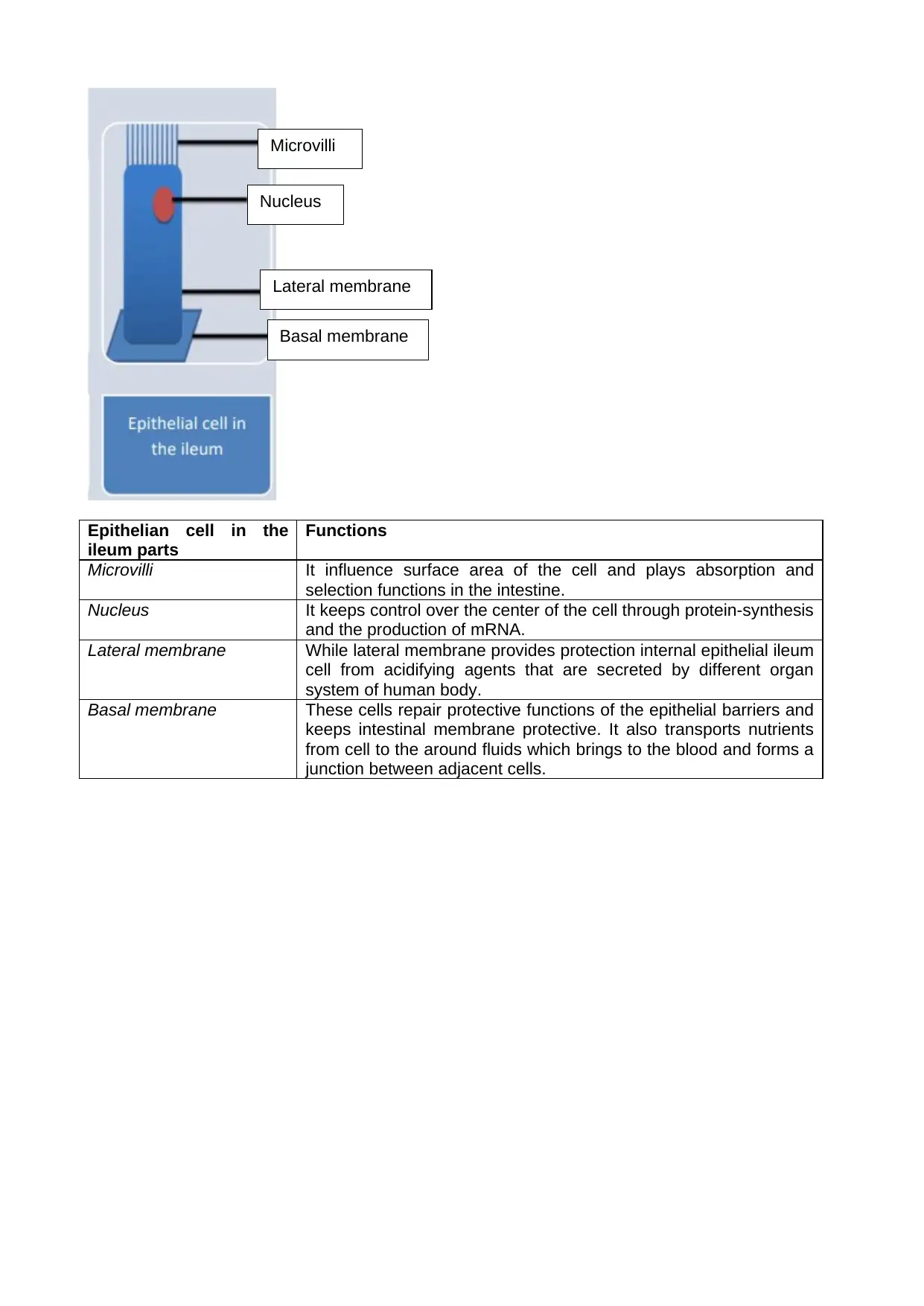
Epithelian cell in the
ileum parts
Functions
Microvilli It influence surface area of the cell and plays absorption and
selection functions in the intestine.
Nucleus It keeps control over the center of the cell through protein-synthesis
and the production of mRNA.
Lateral membrane While lateral membrane provides protection internal epithelial ileum
cell from acidifying agents that are secreted by different organ
system of human body.
Basal membrane These cells repair protective functions of the epithelial barriers and
keeps intestinal membrane protective. It also transports nutrients
from cell to the around fluids which brings to the blood and forms a
junction between adjacent cells.
Microvilli
Nucleus
Lateral membrane
Basal membrane
ileum parts
Functions
Microvilli It influence surface area of the cell and plays absorption and
selection functions in the intestine.
Nucleus It keeps control over the center of the cell through protein-synthesis
and the production of mRNA.
Lateral membrane While lateral membrane provides protection internal epithelial ileum
cell from acidifying agents that are secreted by different organ
system of human body.
Basal membrane These cells repair protective functions of the epithelial barriers and
keeps intestinal membrane protective. It also transports nutrients
from cell to the around fluids which brings to the blood and forms a
junction between adjacent cells.
Microvilli
Nucleus
Lateral membrane
Basal membrane
Paraphrase This Document
Need a fresh take? Get an instant paraphrase of this document with our AI Paraphraser
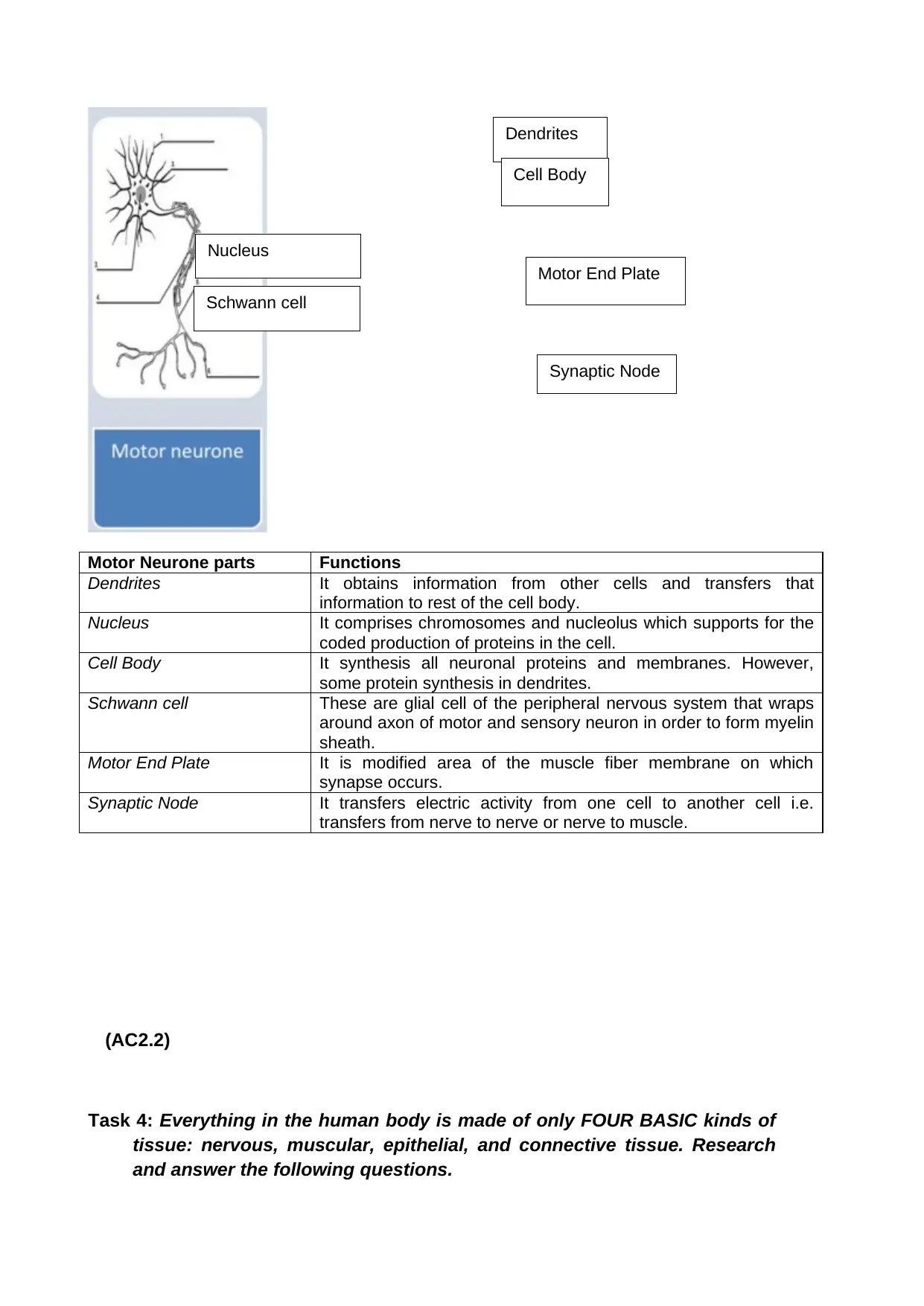
Motor Neurone parts Functions
Dendrites It obtains information from other cells and transfers that
information to rest of the cell body.
Nucleus It comprises chromosomes and nucleolus which supports for the
coded production of proteins in the cell.
Cell Body It synthesis all neuronal proteins and membranes. However,
some protein synthesis in dendrites.
Schwann cell These are glial cell of the peripheral nervous system that wraps
around axon of motor and sensory neuron in order to form myelin
sheath.
Motor End Plate It is modified area of the muscle fiber membrane on which
synapse occurs.
Synaptic Node It transfers electric activity from one cell to another cell i.e.
transfers from nerve to nerve or nerve to muscle.
(AC2.2)
Task 4: Everything in the human body is made of only FOUR BASIC kinds of
tissue: nervous, muscular, epithelial, and connective tissue. Research
and answer the following questions.
Nucleus
Schwann cell
Dendrites
Cell Body
Motor End Plate
Synaptic Node
Dendrites It obtains information from other cells and transfers that
information to rest of the cell body.
Nucleus It comprises chromosomes and nucleolus which supports for the
coded production of proteins in the cell.
Cell Body It synthesis all neuronal proteins and membranes. However,
some protein synthesis in dendrites.
Schwann cell These are glial cell of the peripheral nervous system that wraps
around axon of motor and sensory neuron in order to form myelin
sheath.
Motor End Plate It is modified area of the muscle fiber membrane on which
synapse occurs.
Synaptic Node It transfers electric activity from one cell to another cell i.e.
transfers from nerve to nerve or nerve to muscle.
(AC2.2)
Task 4: Everything in the human body is made of only FOUR BASIC kinds of
tissue: nervous, muscular, epithelial, and connective tissue. Research
and answer the following questions.
Nucleus
Schwann cell
Dendrites
Cell Body
Motor End Plate
Synaptic Node
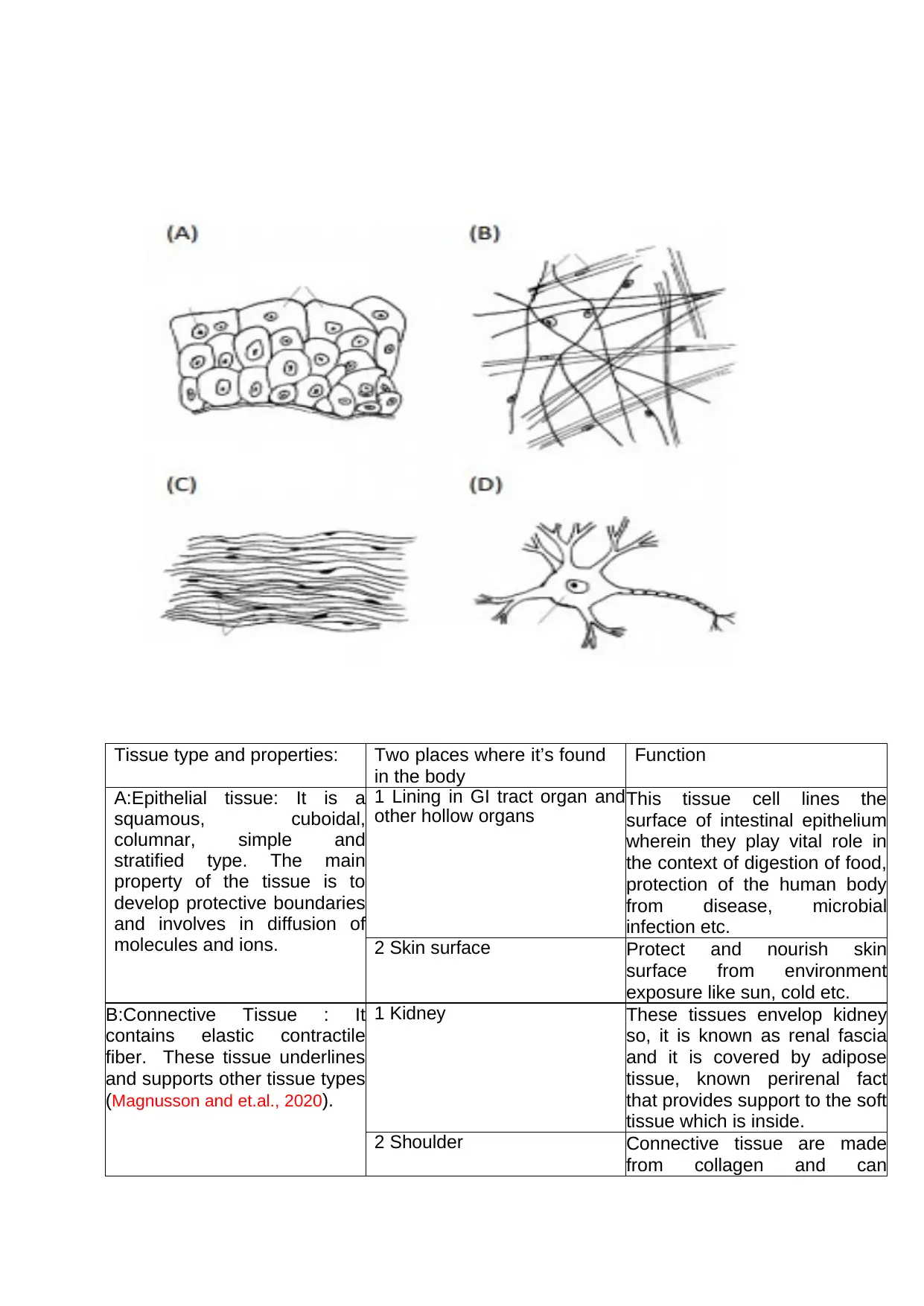
Tissue type and properties: Two places where it’s found
in the body
Function
A:Epithelial tissue: It is a
squamous, cuboidal,
columnar, simple and
stratified type. The main
property of the tissue is to
develop protective boundaries
and involves in diffusion of
molecules and ions.
1 Lining in GI tract organ and
other hollow organs This tissue cell lines the
surface of intestinal epithelium
wherein they play vital role in
the context of digestion of food,
protection of the human body
from disease, microbial
infection etc.
2 Skin surface Protect and nourish skin
surface from environment
exposure like sun, cold etc.
B:Connective Tissue : It
contains elastic contractile
fiber. These tissue underlines
and supports other tissue types
(Magnusson and et.al., 2020).
1 Kidney These tissues envelop kidney
so, it is known as renal fascia
and it is covered by adipose
tissue, known perirenal fact
that provides support to the soft
tissue which is inside.
2 Shoulder Connective tissue are made
from collagen and can
in the body
Function
A:Epithelial tissue: It is a
squamous, cuboidal,
columnar, simple and
stratified type. The main
property of the tissue is to
develop protective boundaries
and involves in diffusion of
molecules and ions.
1 Lining in GI tract organ and
other hollow organs This tissue cell lines the
surface of intestinal epithelium
wherein they play vital role in
the context of digestion of food,
protection of the human body
from disease, microbial
infection etc.
2 Skin surface Protect and nourish skin
surface from environment
exposure like sun, cold etc.
B:Connective Tissue : It
contains elastic contractile
fiber. These tissue underlines
and supports other tissue types
(Magnusson and et.al., 2020).
1 Kidney These tissues envelop kidney
so, it is known as renal fascia
and it is covered by adipose
tissue, known perirenal fact
that provides support to the soft
tissue which is inside.
2 Shoulder Connective tissue are made
from collagen and can
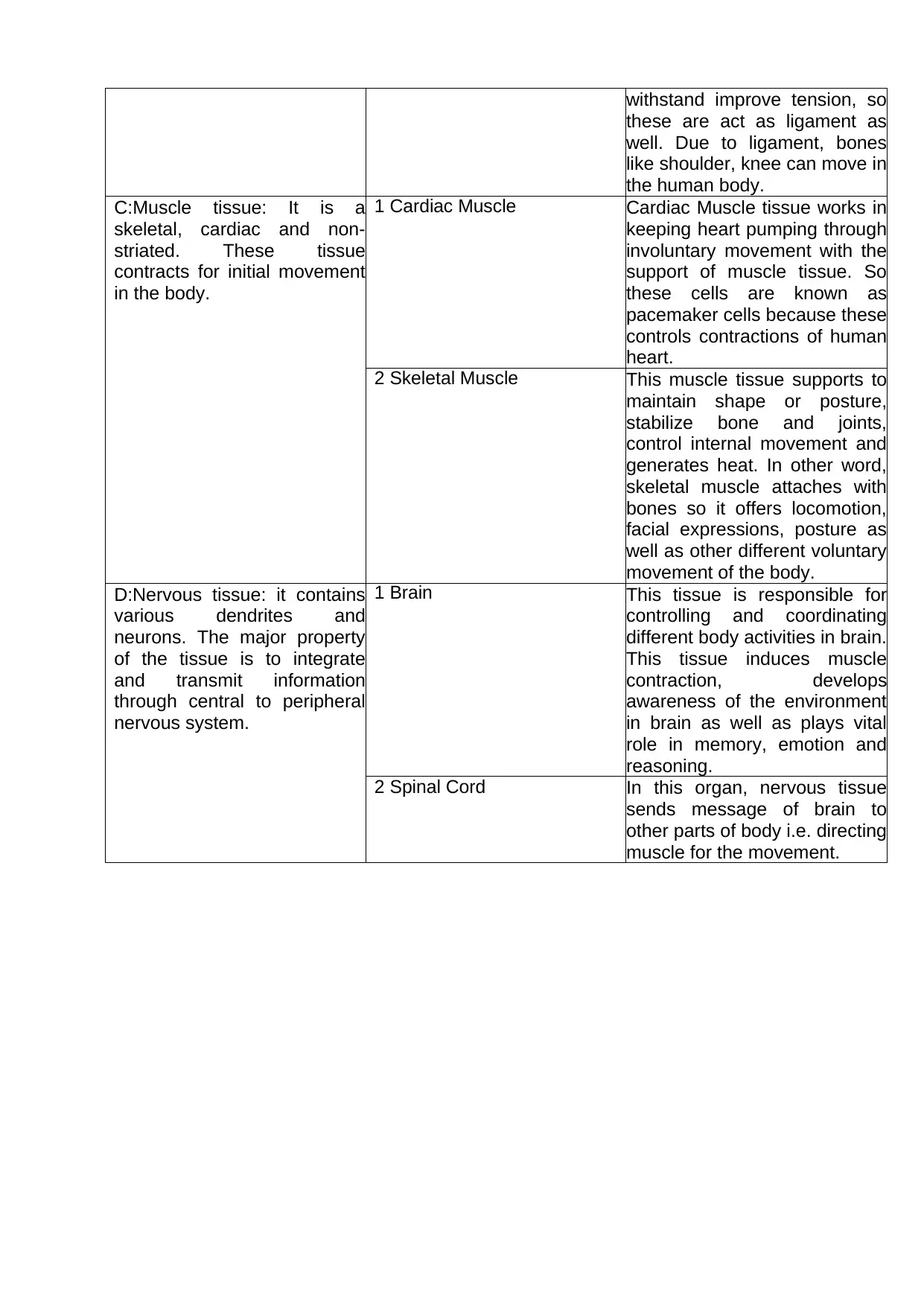
withstand improve tension, so
these are act as ligament as
well. Due to ligament, bones
like shoulder, knee can move in
the human body.
C:Muscle tissue: It is a
skeletal, cardiac and non-
striated. These tissue
contracts for initial movement
in the body.
1 Cardiac Muscle Cardiac Muscle tissue works in
keeping heart pumping through
involuntary movement with the
support of muscle tissue. So
these cells are known as
pacemaker cells because these
controls contractions of human
heart.
2 Skeletal Muscle This muscle tissue supports to
maintain shape or posture,
stabilize bone and joints,
control internal movement and
generates heat. In other word,
skeletal muscle attaches with
bones so it offers locomotion,
facial expressions, posture as
well as other different voluntary
movement of the body.
D:Nervous tissue: it contains
various dendrites and
neurons. The major property
of the tissue is to integrate
and transmit information
through central to peripheral
nervous system.
1 Brain This tissue is responsible for
controlling and coordinating
different body activities in brain.
This tissue induces muscle
contraction, develops
awareness of the environment
in brain as well as plays vital
role in memory, emotion and
reasoning.
2 Spinal Cord In this organ, nervous tissue
sends message of brain to
other parts of body i.e. directing
muscle for the movement.
these are act as ligament as
well. Due to ligament, bones
like shoulder, knee can move in
the human body.
C:Muscle tissue: It is a
skeletal, cardiac and non-
striated. These tissue
contracts for initial movement
in the body.
1 Cardiac Muscle Cardiac Muscle tissue works in
keeping heart pumping through
involuntary movement with the
support of muscle tissue. So
these cells are known as
pacemaker cells because these
controls contractions of human
heart.
2 Skeletal Muscle This muscle tissue supports to
maintain shape or posture,
stabilize bone and joints,
control internal movement and
generates heat. In other word,
skeletal muscle attaches with
bones so it offers locomotion,
facial expressions, posture as
well as other different voluntary
movement of the body.
D:Nervous tissue: it contains
various dendrites and
neurons. The major property
of the tissue is to integrate
and transmit information
through central to peripheral
nervous system.
1 Brain This tissue is responsible for
controlling and coordinating
different body activities in brain.
This tissue induces muscle
contraction, develops
awareness of the environment
in brain as well as plays vital
role in memory, emotion and
reasoning.
2 Spinal Cord In this organ, nervous tissue
sends message of brain to
other parts of body i.e. directing
muscle for the movement.
Secure Best Marks with AI Grader
Need help grading? Try our AI Grader for instant feedback on your assignments.
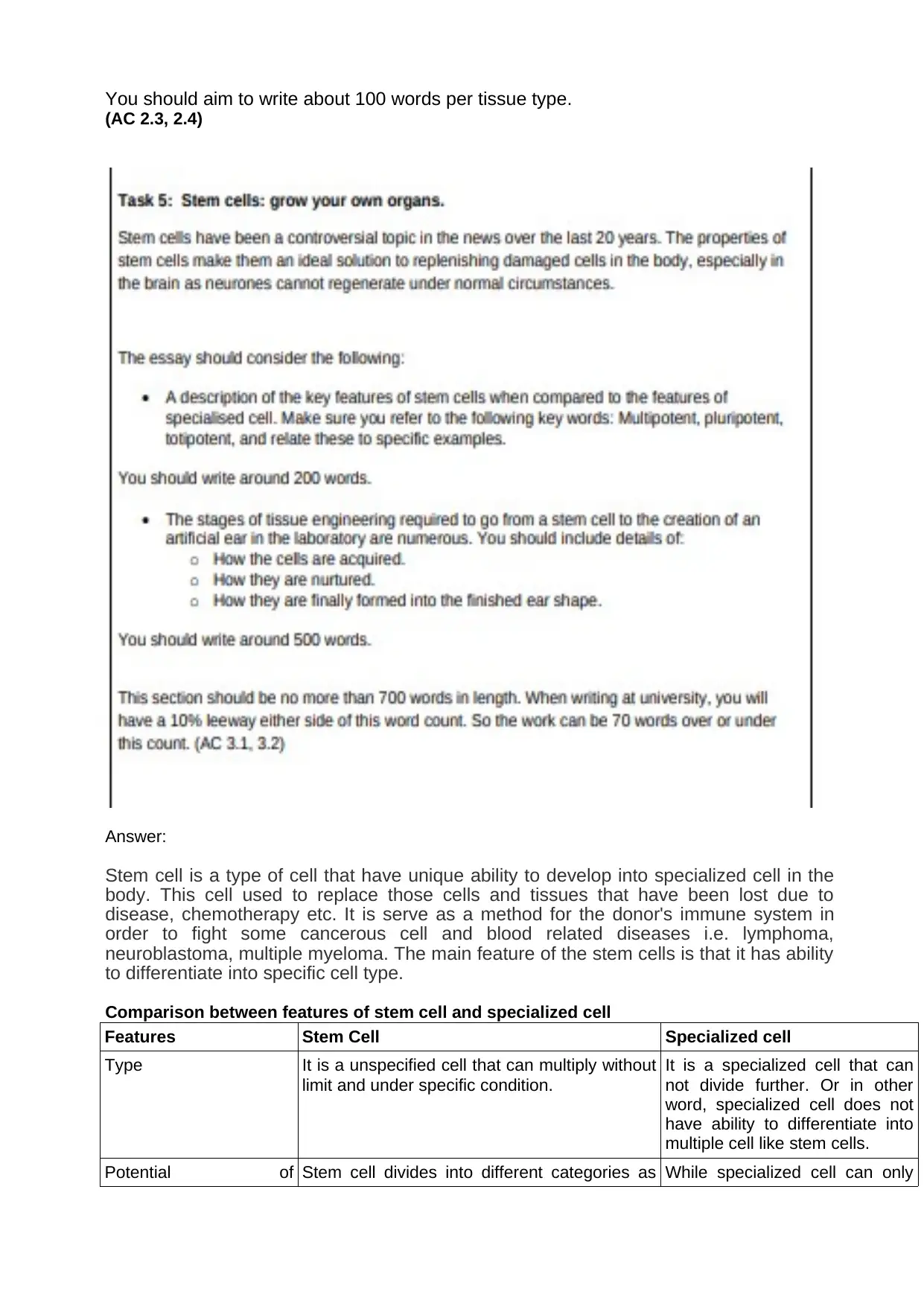
You should aim to write about 100 words per tissue type.
(AC 2.3, 2.4)
Answer:
Stem cell is a type of cell that have unique ability to develop into specialized cell in the
body. This cell used to replace those cells and tissues that have been lost due to
disease, chemotherapy etc. It is serve as a method for the donor's immune system in
order to fight some cancerous cell and blood related diseases i.e. lymphoma,
neuroblastoma, multiple myeloma. The main feature of the stem cells is that it has ability
to differentiate into specific cell type.
Comparison between features of stem cell and specialized cell
Features Stem Cell Specialized cell
Type It is a unspecified cell that can multiply without
limit and under specific condition.
It is a specialized cell that can
not divide further. Or in other
word, specialized cell does not
have ability to differentiate into
multiple cell like stem cells.
Potential of Stem cell divides into different categories as While specialized cell can only
(AC 2.3, 2.4)
Answer:
Stem cell is a type of cell that have unique ability to develop into specialized cell in the
body. This cell used to replace those cells and tissues that have been lost due to
disease, chemotherapy etc. It is serve as a method for the donor's immune system in
order to fight some cancerous cell and blood related diseases i.e. lymphoma,
neuroblastoma, multiple myeloma. The main feature of the stem cells is that it has ability
to differentiate into specific cell type.
Comparison between features of stem cell and specialized cell
Features Stem Cell Specialized cell
Type It is a unspecified cell that can multiply without
limit and under specific condition.
It is a specialized cell that can
not divide further. Or in other
word, specialized cell does not
have ability to differentiate into
multiple cell like stem cells.
Potential of Stem cell divides into different categories as While specialized cell can only
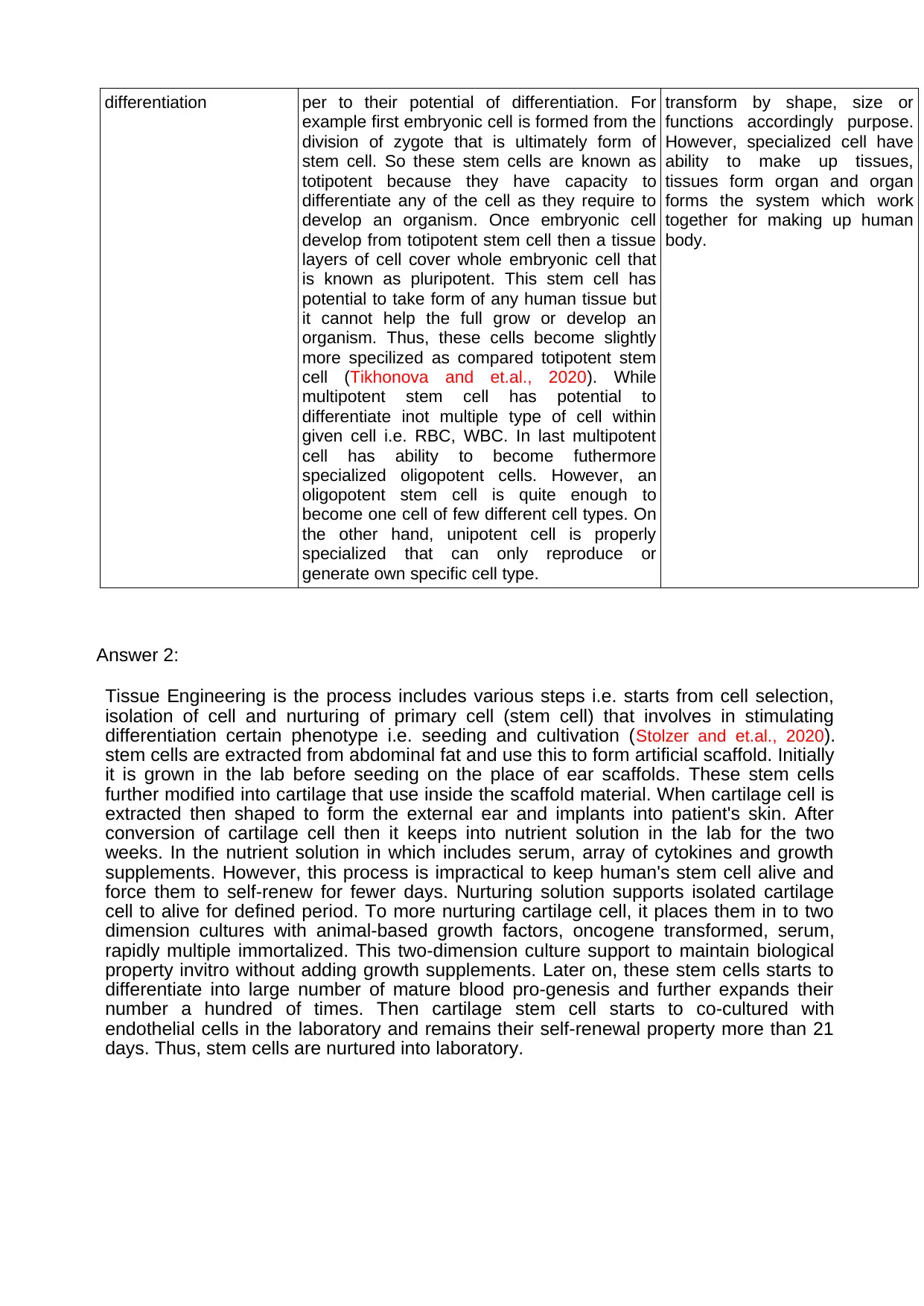
differentiation per to their potential of differentiation. For
example first embryonic cell is formed from the
division of zygote that is ultimately form of
stem cell. So these stem cells are known as
totipotent because they have capacity to
differentiate any of the cell as they require to
develop an organism. Once embryonic cell
develop from totipotent stem cell then a tissue
layers of cell cover whole embryonic cell that
is known as pluripotent. This stem cell has
potential to take form of any human tissue but
it cannot help the full grow or develop an
organism. Thus, these cells become slightly
more specilized as compared totipotent stem
cell (Tikhonova and et.al., 2020). While
multipotent stem cell has potential to
differentiate inot multiple type of cell within
given cell i.e. RBC, WBC. In last multipotent
cell has ability to become futhermore
specialized oligopotent cells. However, an
oligopotent stem cell is quite enough to
become one cell of few different cell types. On
the other hand, unipotent cell is properly
specialized that can only reproduce or
generate own specific cell type.
transform by shape, size or
functions accordingly purpose.
However, specialized cell have
ability to make up tissues,
tissues form organ and organ
forms the system which work
together for making up human
body.
Answer 2:
Tissue Engineering is the process includes various steps i.e. starts from cell selection,
isolation of cell and nurturing of primary cell (stem cell) that involves in stimulating
differentiation certain phenotype i.e. seeding and cultivation (Stolzer and et.al., 2020).
stem cells are extracted from abdominal fat and use this to form artificial scaffold. Initially
it is grown in the lab before seeding on the place of ear scaffolds. These stem cells
further modified into cartilage that use inside the scaffold material. When cartilage cell is
extracted then shaped to form the external ear and implants into patient's skin. After
conversion of cartilage cell then it keeps into nutrient solution in the lab for the two
weeks. In the nutrient solution in which includes serum, array of cytokines and growth
supplements. However, this process is impractical to keep human's stem cell alive and
force them to self-renew for fewer days. Nurturing solution supports isolated cartilage
cell to alive for defined period. To more nurturing cartilage cell, it places them in to two
dimension cultures with animal-based growth factors, oncogene transformed, serum,
rapidly multiple immortalized. This two-dimension culture support to maintain biological
property invitro without adding growth supplements. Later on, these stem cells starts to
differentiate into large number of mature blood pro-genesis and further expands their
number a hundred of times. Then cartilage stem cell starts to co-cultured with
endothelial cells in the laboratory and remains their self-renewal property more than 21
days. Thus, stem cells are nurtured into laboratory.
example first embryonic cell is formed from the
division of zygote that is ultimately form of
stem cell. So these stem cells are known as
totipotent because they have capacity to
differentiate any of the cell as they require to
develop an organism. Once embryonic cell
develop from totipotent stem cell then a tissue
layers of cell cover whole embryonic cell that
is known as pluripotent. This stem cell has
potential to take form of any human tissue but
it cannot help the full grow or develop an
organism. Thus, these cells become slightly
more specilized as compared totipotent stem
cell (Tikhonova and et.al., 2020). While
multipotent stem cell has potential to
differentiate inot multiple type of cell within
given cell i.e. RBC, WBC. In last multipotent
cell has ability to become futhermore
specialized oligopotent cells. However, an
oligopotent stem cell is quite enough to
become one cell of few different cell types. On
the other hand, unipotent cell is properly
specialized that can only reproduce or
generate own specific cell type.
transform by shape, size or
functions accordingly purpose.
However, specialized cell have
ability to make up tissues,
tissues form organ and organ
forms the system which work
together for making up human
body.
Answer 2:
Tissue Engineering is the process includes various steps i.e. starts from cell selection,
isolation of cell and nurturing of primary cell (stem cell) that involves in stimulating
differentiation certain phenotype i.e. seeding and cultivation (Stolzer and et.al., 2020).
stem cells are extracted from abdominal fat and use this to form artificial scaffold. Initially
it is grown in the lab before seeding on the place of ear scaffolds. These stem cells
further modified into cartilage that use inside the scaffold material. When cartilage cell is
extracted then shaped to form the external ear and implants into patient's skin. After
conversion of cartilage cell then it keeps into nutrient solution in the lab for the two
weeks. In the nutrient solution in which includes serum, array of cytokines and growth
supplements. However, this process is impractical to keep human's stem cell alive and
force them to self-renew for fewer days. Nurturing solution supports isolated cartilage
cell to alive for defined period. To more nurturing cartilage cell, it places them in to two
dimension cultures with animal-based growth factors, oncogene transformed, serum,
rapidly multiple immortalized. This two-dimension culture support to maintain biological
property invitro without adding growth supplements. Later on, these stem cells starts to
differentiate into large number of mature blood pro-genesis and further expands their
number a hundred of times. Then cartilage stem cell starts to co-cultured with
endothelial cells in the laboratory and remains their self-renewal property more than 21
days. Thus, stem cells are nurtured into laboratory.
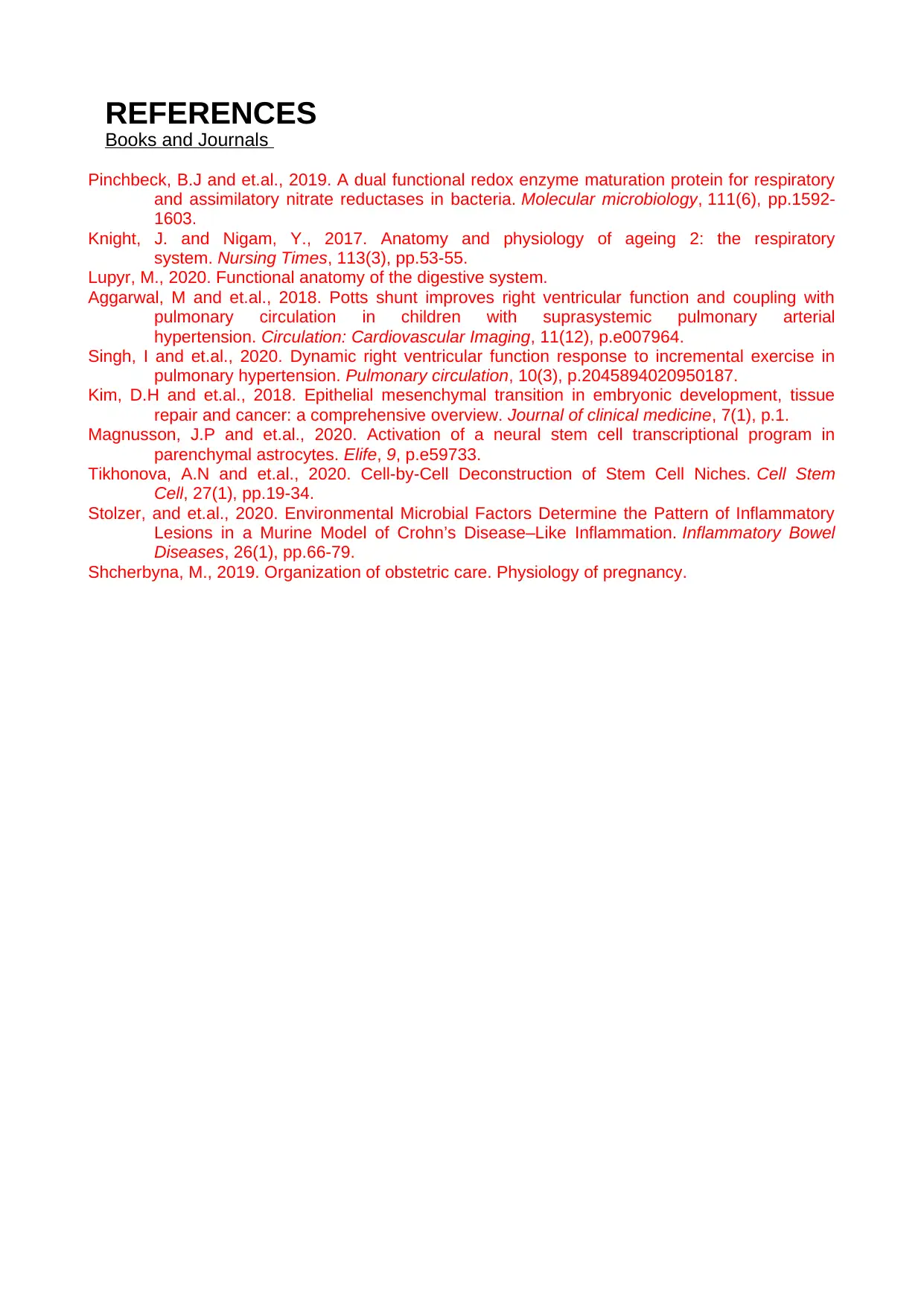
REFERENCES
Books and Journals
Pinchbeck, B.J and et.al., 2019. A dual functional redox enzyme maturation protein for respiratory
and assimilatory nitrate reductases in bacteria. Molecular microbiology, 111(6), pp.1592-
1603.
Knight, J. and Nigam, Y., 2017. Anatomy and physiology of ageing 2: the respiratory
system. Nursing Times, 113(3), pp.53-55.
Lupyr, M., 2020. Functional anatomy of the digestive system.
Aggarwal, M and et.al., 2018. Potts shunt improves right ventricular function and coupling with
pulmonary circulation in children with suprasystemic pulmonary arterial
hypertension. Circulation: Cardiovascular Imaging, 11(12), p.e007964.
Singh, I and et.al., 2020. Dynamic right ventricular function response to incremental exercise in
pulmonary hypertension. Pulmonary circulation, 10(3), p.2045894020950187.
Kim, D.H and et.al., 2018. Epithelial mesenchymal transition in embryonic development, tissue
repair and cancer: a comprehensive overview. Journal of clinical medicine, 7(1), p.1.
Magnusson, J.P and et.al., 2020. Activation of a neural stem cell transcriptional program in
parenchymal astrocytes. Elife, 9, p.e59733.
Tikhonova, A.N and et.al., 2020. Cell-by-Cell Deconstruction of Stem Cell Niches. Cell Stem
Cell, 27(1), pp.19-34.
Stolzer, and et.al., 2020. Environmental Microbial Factors Determine the Pattern of Inflammatory
Lesions in a Murine Model of Crohn’s Disease–Like Inflammation. Inflammatory Bowel
Diseases, 26(1), pp.66-79.
Shcherbyna, M., 2019. Organization of obstetric care. Physiology of pregnancy.
Books and Journals
Pinchbeck, B.J and et.al., 2019. A dual functional redox enzyme maturation protein for respiratory
and assimilatory nitrate reductases in bacteria. Molecular microbiology, 111(6), pp.1592-
1603.
Knight, J. and Nigam, Y., 2017. Anatomy and physiology of ageing 2: the respiratory
system. Nursing Times, 113(3), pp.53-55.
Lupyr, M., 2020. Functional anatomy of the digestive system.
Aggarwal, M and et.al., 2018. Potts shunt improves right ventricular function and coupling with
pulmonary circulation in children with suprasystemic pulmonary arterial
hypertension. Circulation: Cardiovascular Imaging, 11(12), p.e007964.
Singh, I and et.al., 2020. Dynamic right ventricular function response to incremental exercise in
pulmonary hypertension. Pulmonary circulation, 10(3), p.2045894020950187.
Kim, D.H and et.al., 2018. Epithelial mesenchymal transition in embryonic development, tissue
repair and cancer: a comprehensive overview. Journal of clinical medicine, 7(1), p.1.
Magnusson, J.P and et.al., 2020. Activation of a neural stem cell transcriptional program in
parenchymal astrocytes. Elife, 9, p.e59733.
Tikhonova, A.N and et.al., 2020. Cell-by-Cell Deconstruction of Stem Cell Niches. Cell Stem
Cell, 27(1), pp.19-34.
Stolzer, and et.al., 2020. Environmental Microbial Factors Determine the Pattern of Inflammatory
Lesions in a Murine Model of Crohn’s Disease–Like Inflammation. Inflammatory Bowel
Diseases, 26(1), pp.66-79.
Shcherbyna, M., 2019. Organization of obstetric care. Physiology of pregnancy.
Paraphrase This Document
Need a fresh take? Get an instant paraphrase of this document with our AI Paraphraser
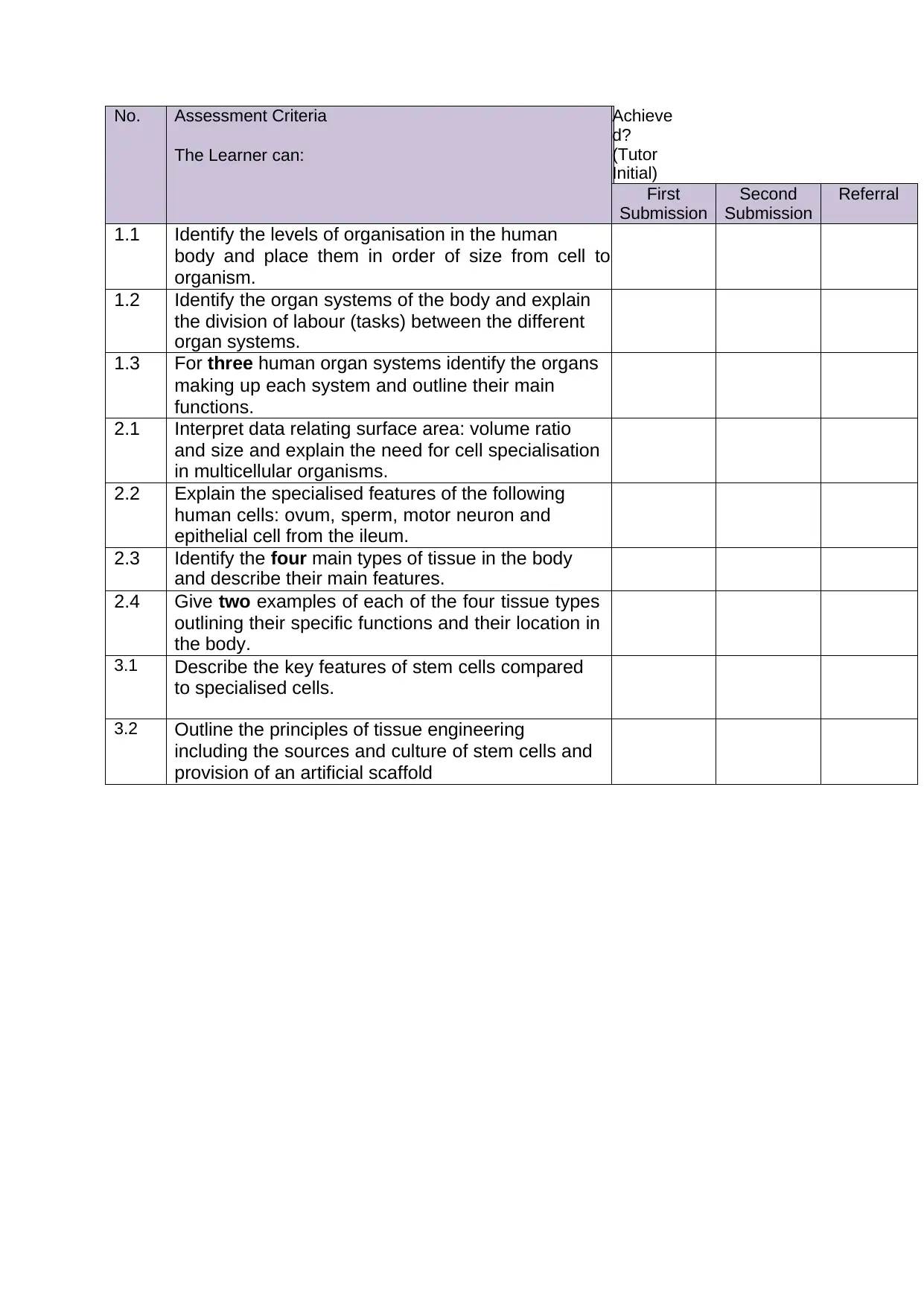
No. Assessment Criteria
The Learner can:
Achieve
d?
(Tutor
Initial)
First
Submission
Second
Submission
Referral
1.1 Identify the levels of organisation in the human
body and place them in order of size from cell to
organism.
1.2 Identify the organ systems of the body and explain
the division of labour (tasks) between the different
organ systems.
1.3 For three human organ systems identify the organs
making up each system and outline their main
functions.
2.1 Interpret data relating surface area: volume ratio
and size and explain the need for cell specialisation
in multicellular organisms.
2.2 Explain the specialised features of the following
human cells: ovum, sperm, motor neuron and
epithelial cell from the ileum.
2.3 Identify the four main types of tissue in the body
and describe their main features.
2.4 Give two examples of each of the four tissue types
outlining their specific functions and their location in
the body.
3.1 Describe the key features of stem cells compared
to specialised cells.
3.2 Outline the principles of tissue engineering
including the sources and culture of stem cells and
provision of an artificial scaffold
The Learner can:
Achieve
d?
(Tutor
Initial)
First
Submission
Second
Submission
Referral
1.1 Identify the levels of organisation in the human
body and place them in order of size from cell to
organism.
1.2 Identify the organ systems of the body and explain
the division of labour (tasks) between the different
organ systems.
1.3 For three human organ systems identify the organs
making up each system and outline their main
functions.
2.1 Interpret data relating surface area: volume ratio
and size and explain the need for cell specialisation
in multicellular organisms.
2.2 Explain the specialised features of the following
human cells: ovum, sperm, motor neuron and
epithelial cell from the ileum.
2.3 Identify the four main types of tissue in the body
and describe their main features.
2.4 Give two examples of each of the four tissue types
outlining their specific functions and their location in
the body.
3.1 Describe the key features of stem cells compared
to specialised cells.
3.2 Outline the principles of tissue engineering
including the sources and culture of stem cells and
provision of an artificial scaffold
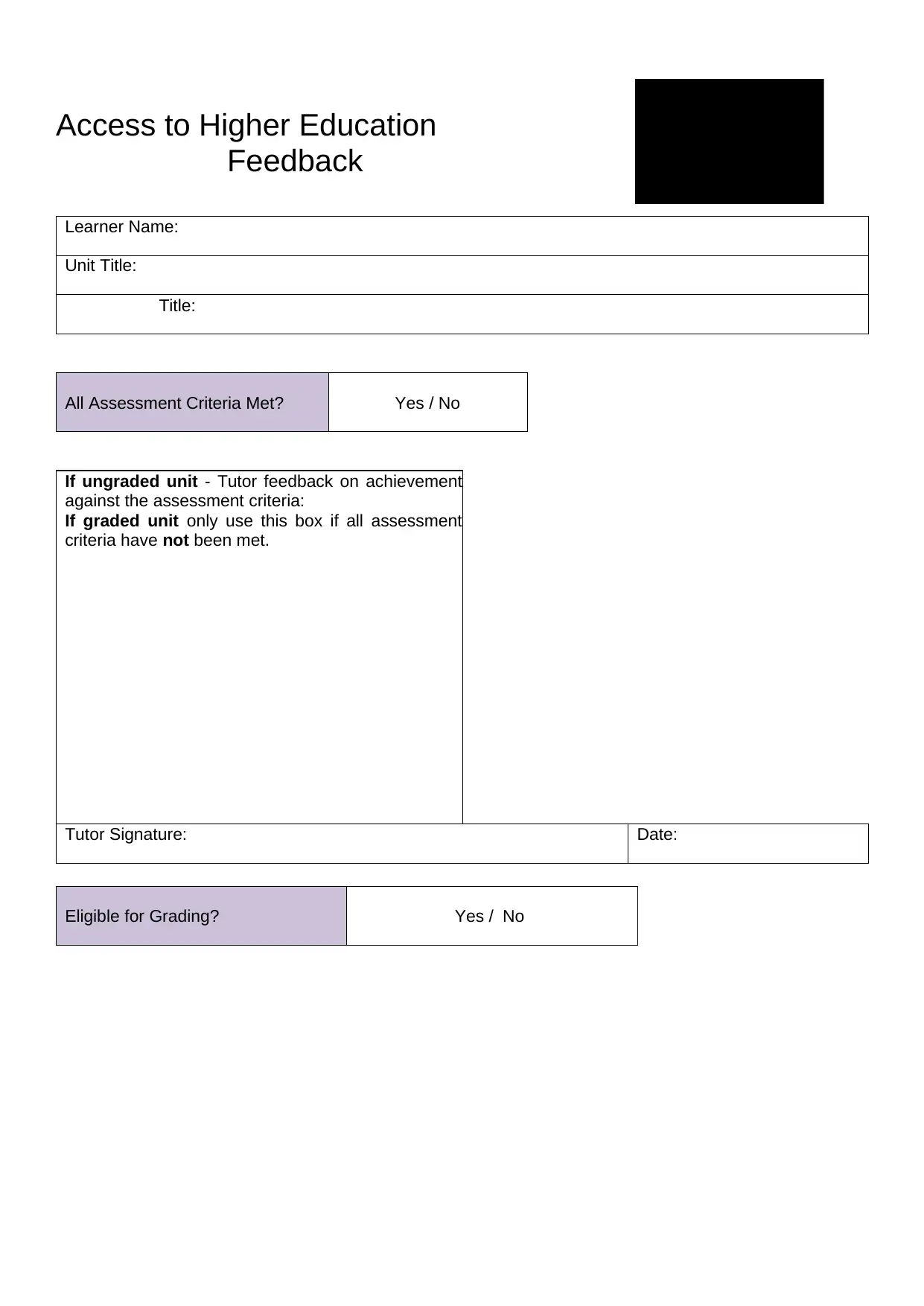
Access to Higher Education
Feedback
Learner Name:
Unit Title:
Title:
All Assessment Criteria Met? Yes / No
If ungraded unit - Tutor feedback on achievement
against the assessment criteria:
If graded unit only use this box if all assessment
criteria have not been met.
Tutor Signature: Date:
Eligible for Grading? Yes / No
Feedback
Learner Name:
Unit Title:
Title:
All Assessment Criteria Met? Yes / No
If ungraded unit - Tutor feedback on achievement
against the assessment criteria:
If graded unit only use this box if all assessment
criteria have not been met.
Tutor Signature: Date:
Eligible for Grading? Yes / No
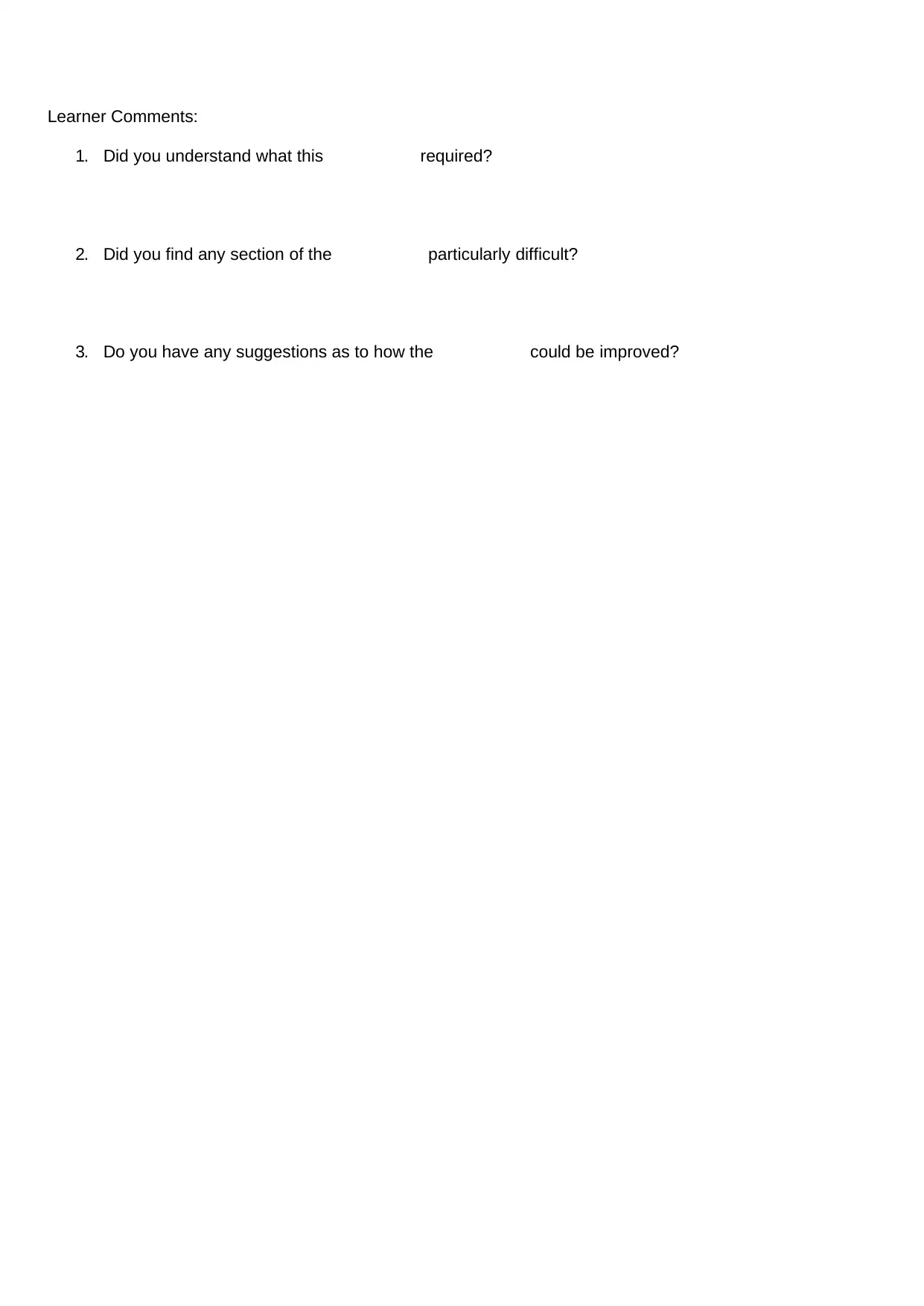
Learner Comments:
1. Did you understand what this required?
2. Did you find any section of the particularly difficult?
3. Do you have any suggestions as to how the could be improved?
1. Did you understand what this required?
2. Did you find any section of the particularly difficult?
3. Do you have any suggestions as to how the could be improved?
1 out of 22
Related Documents
Your All-in-One AI-Powered Toolkit for Academic Success.
+13062052269
info@desklib.com
Available 24*7 on WhatsApp / Email
![[object Object]](/_next/static/media/star-bottom.7253800d.svg)
Unlock your academic potential
© 2024 | Zucol Services PVT LTD | All rights reserved.





